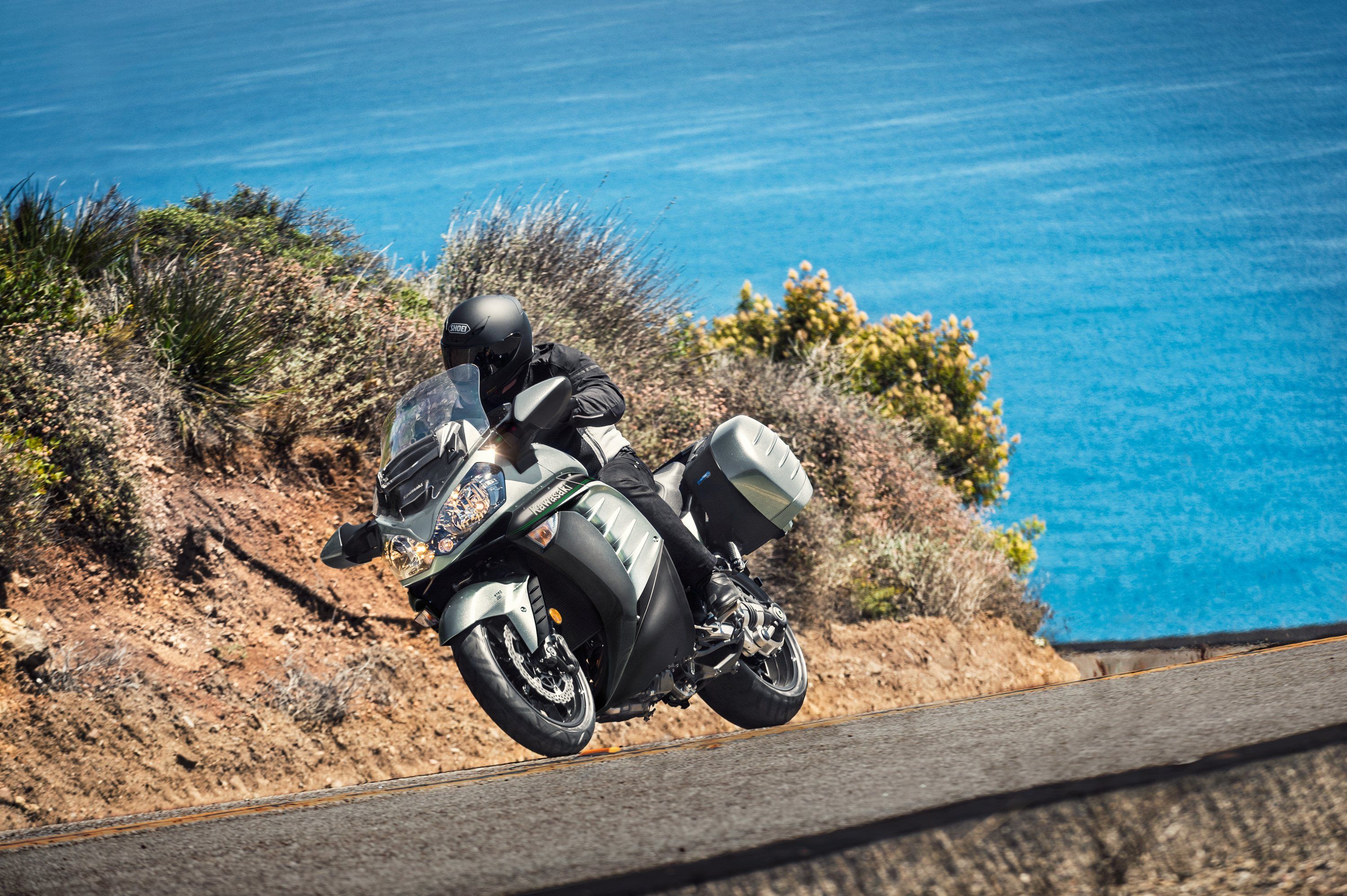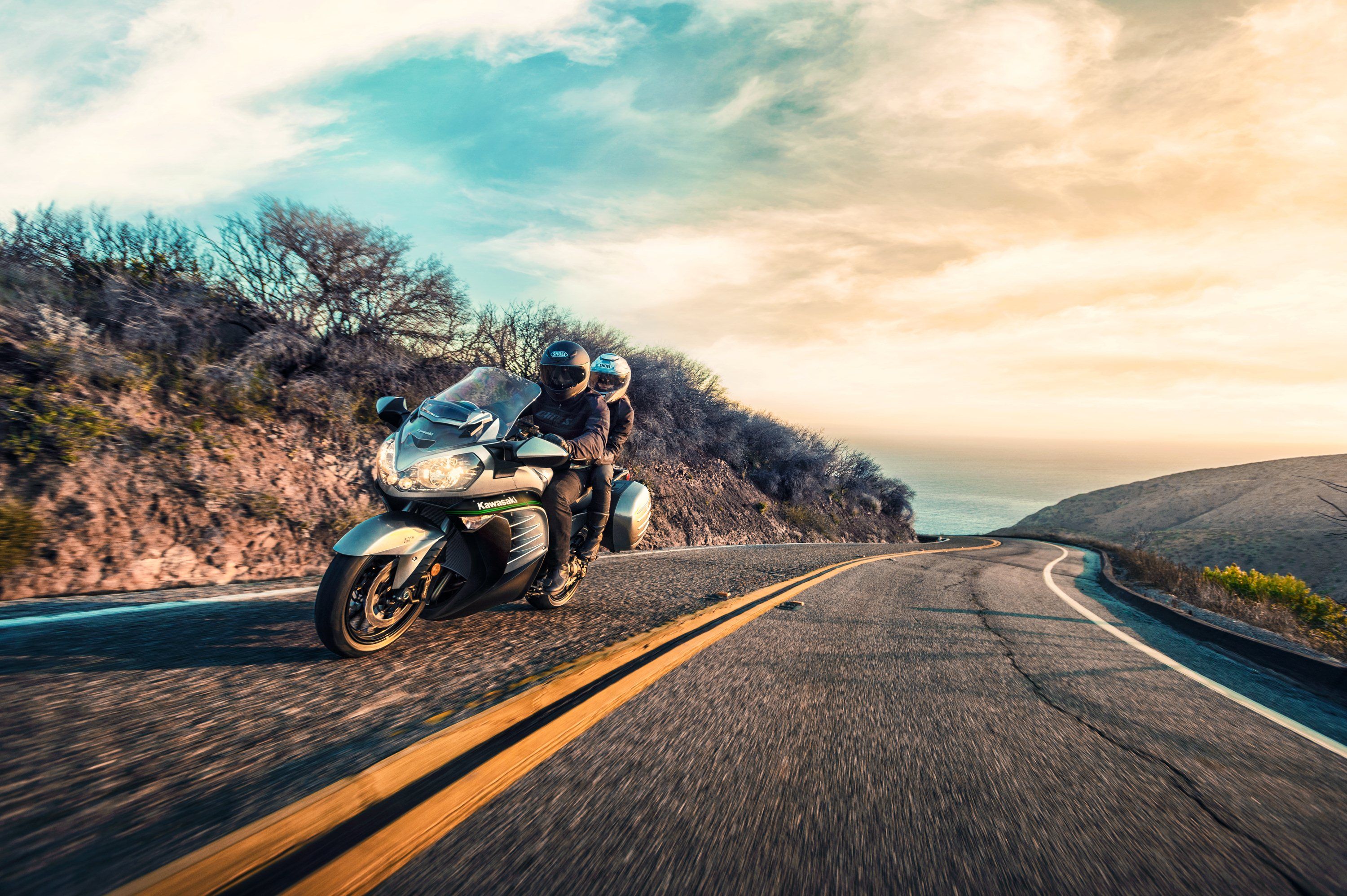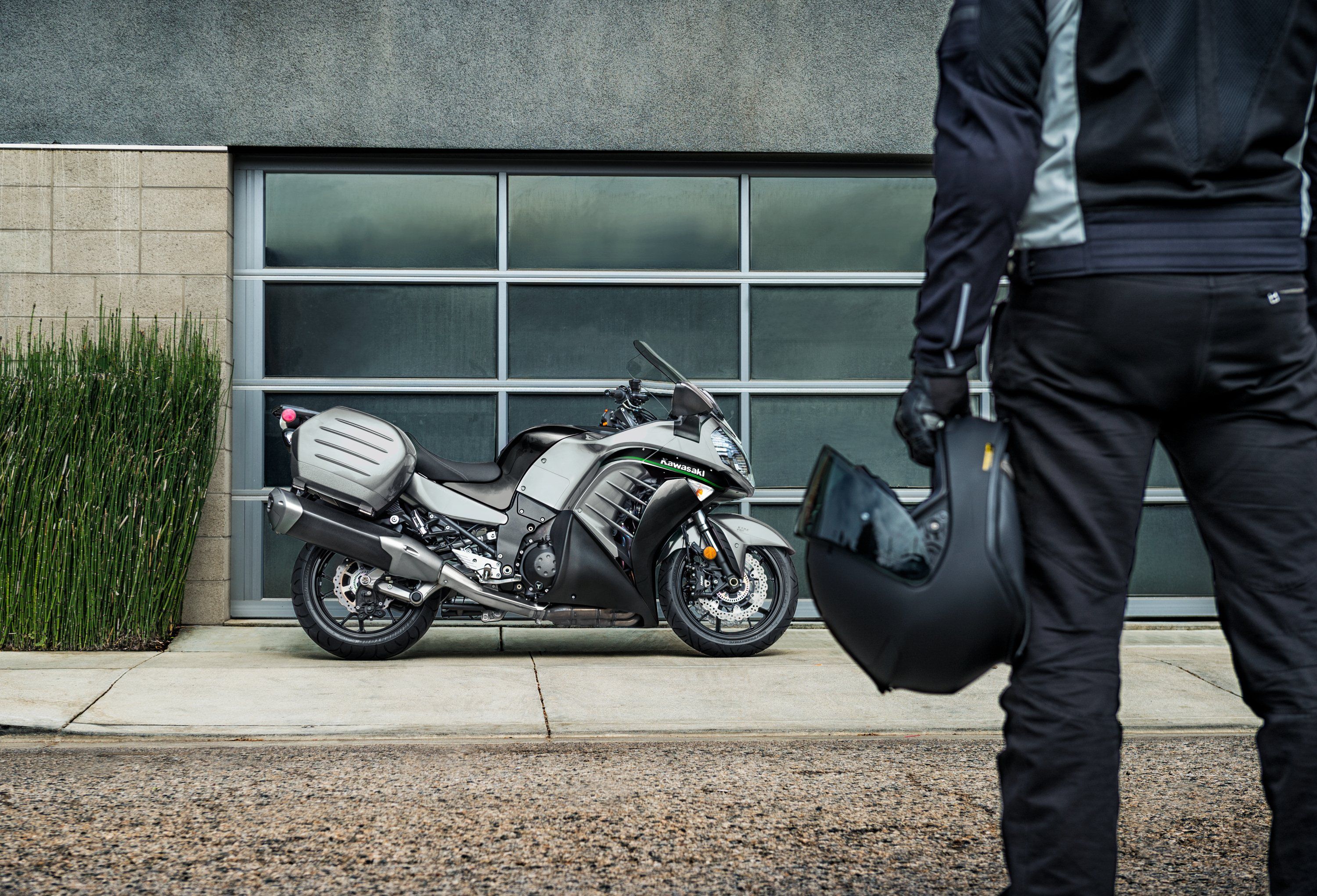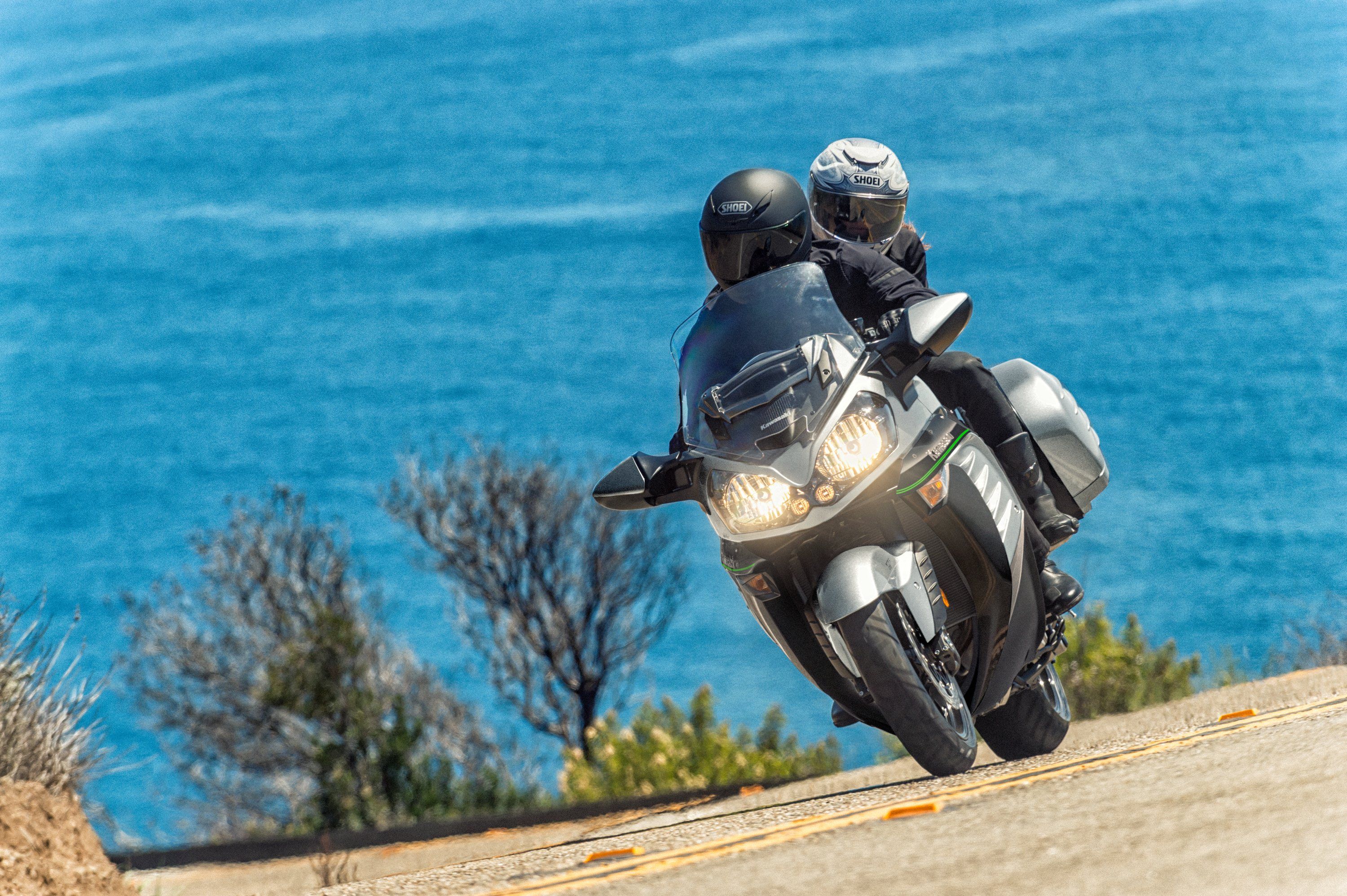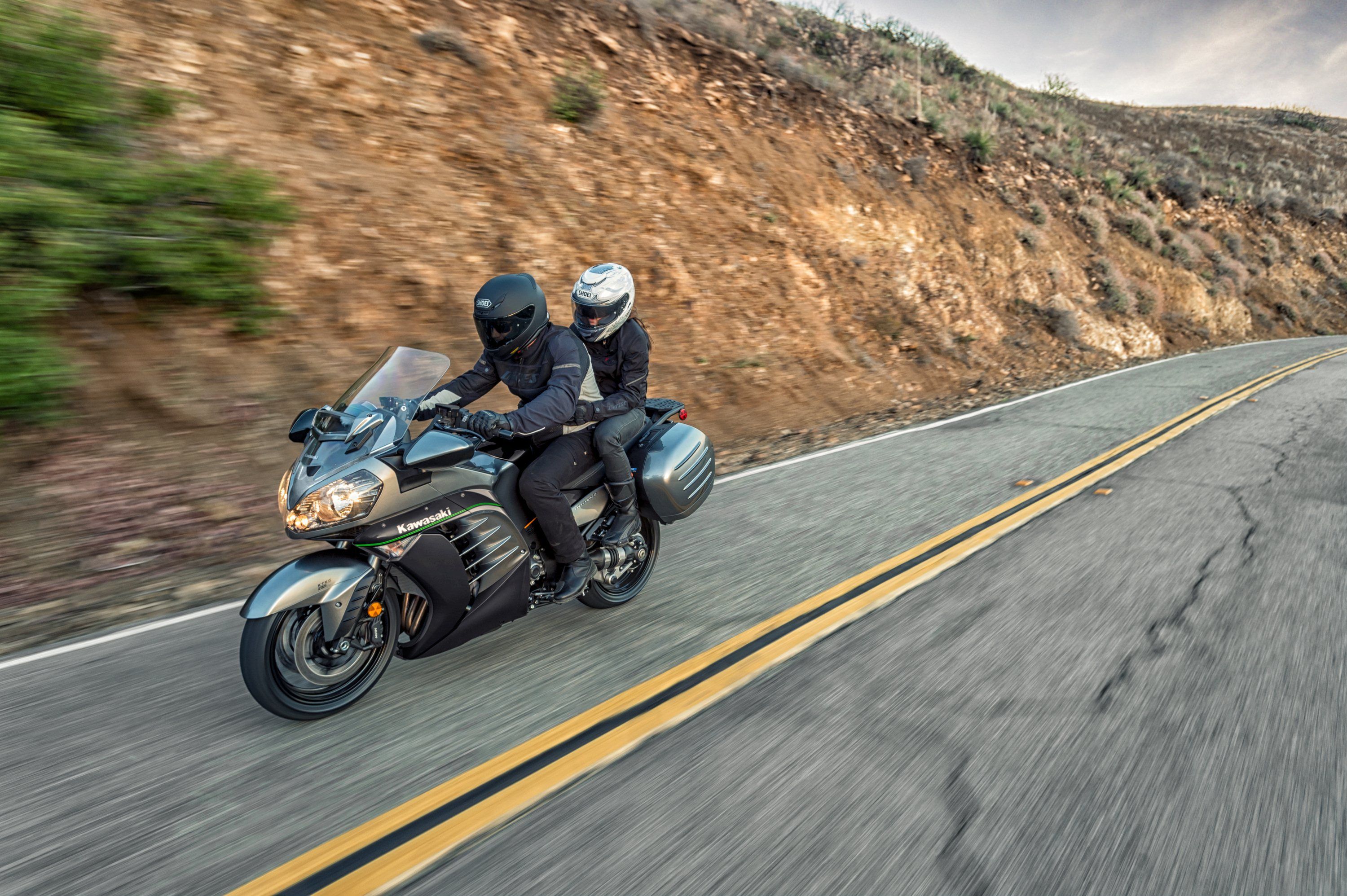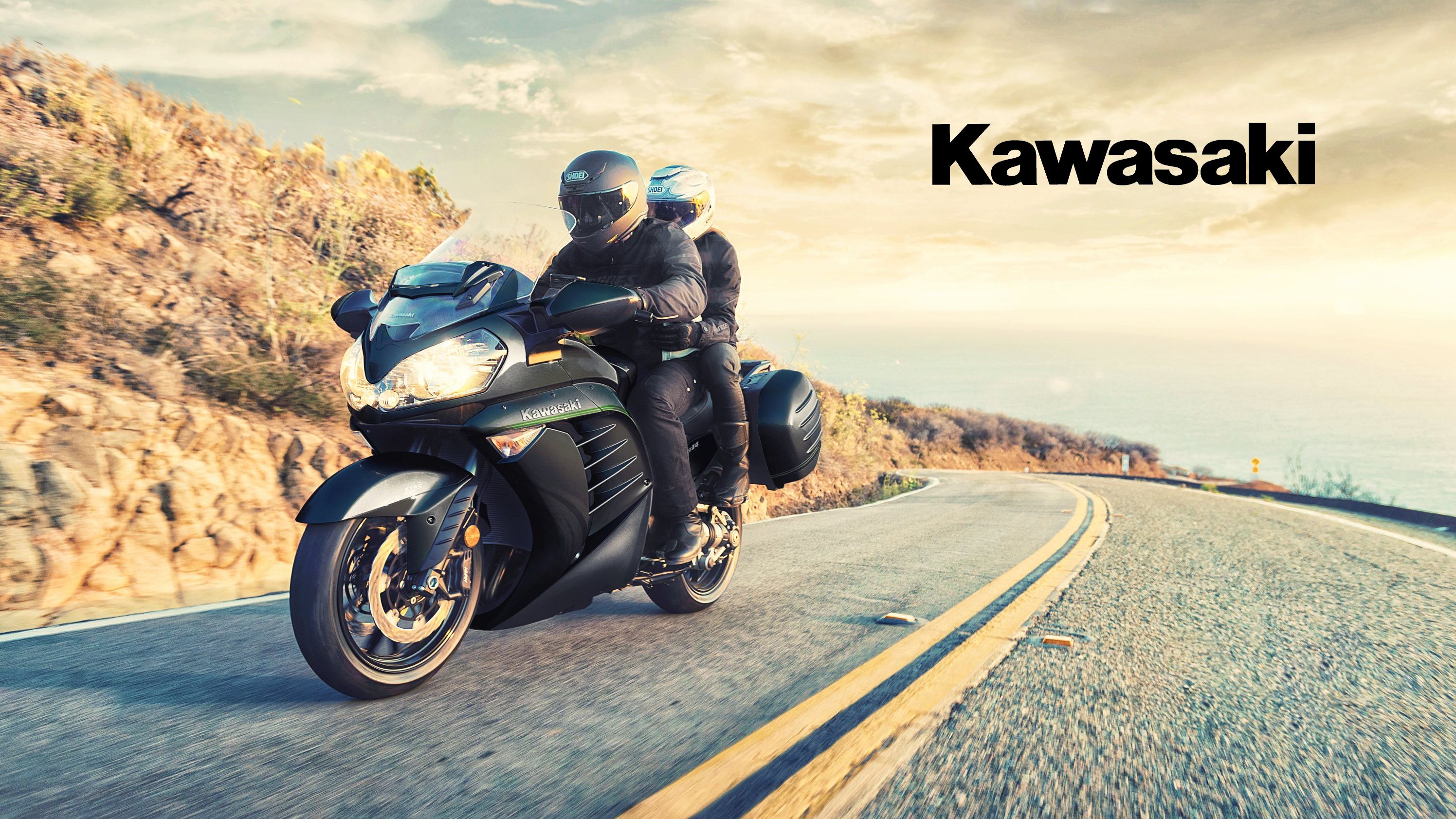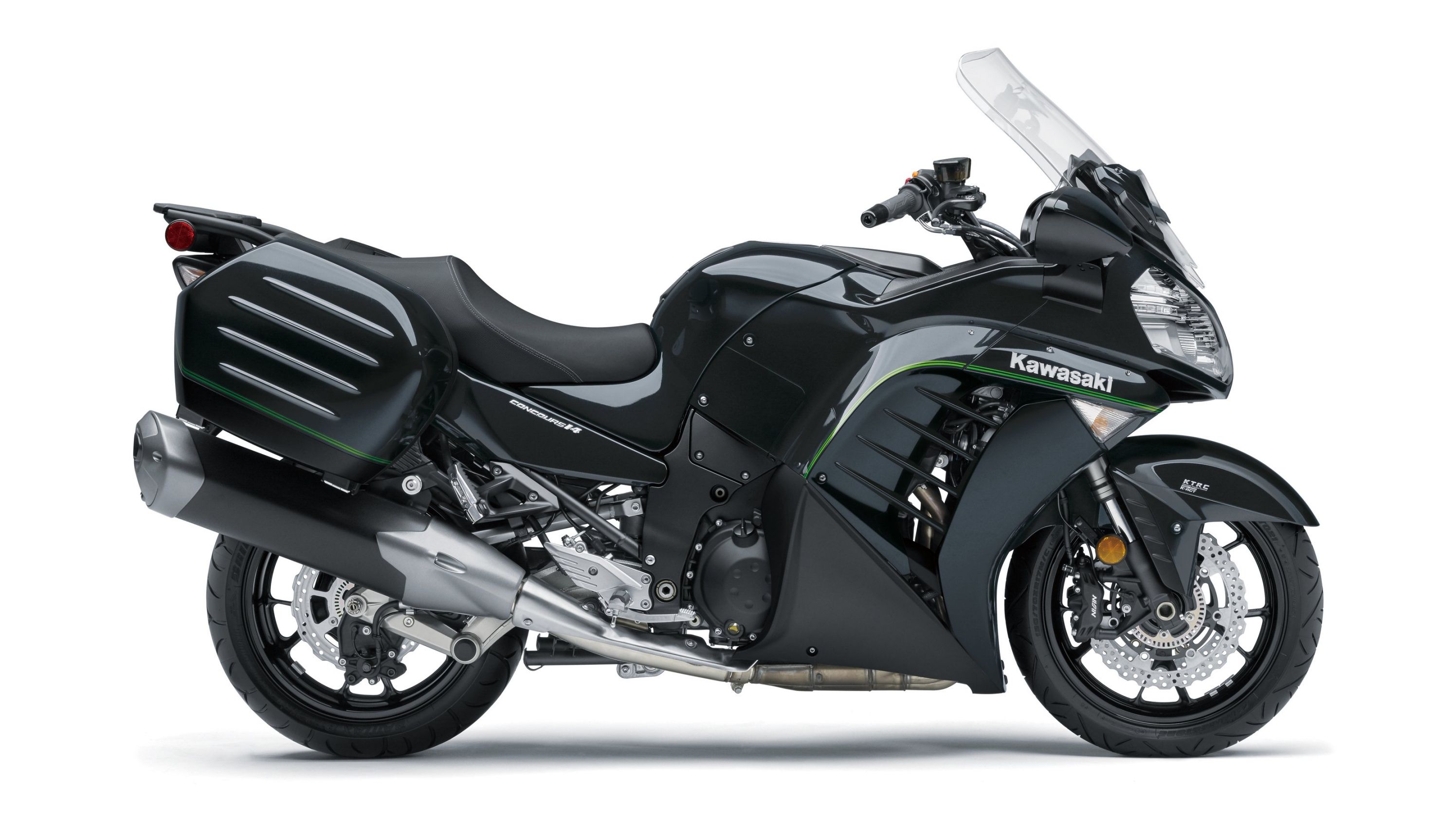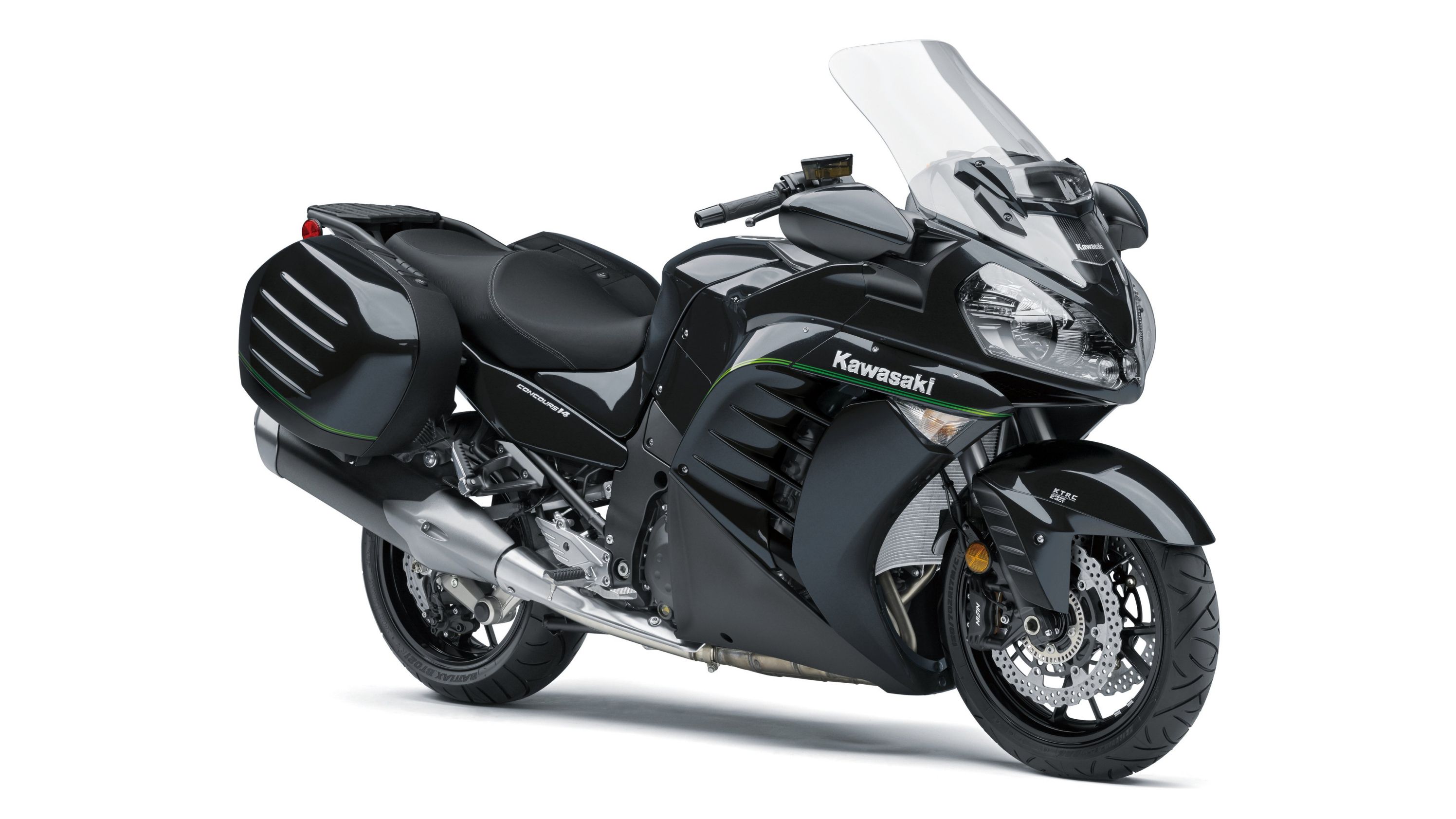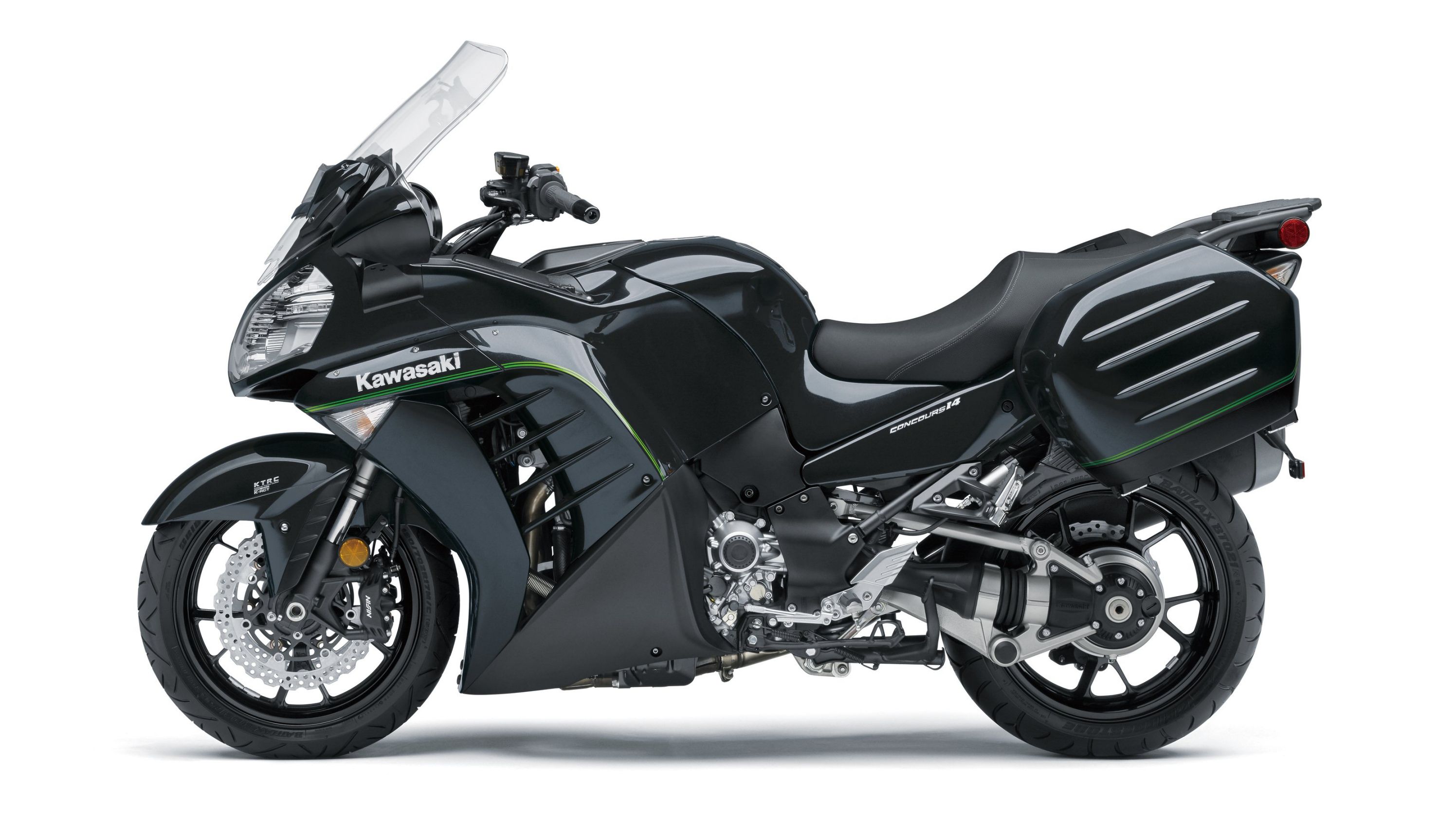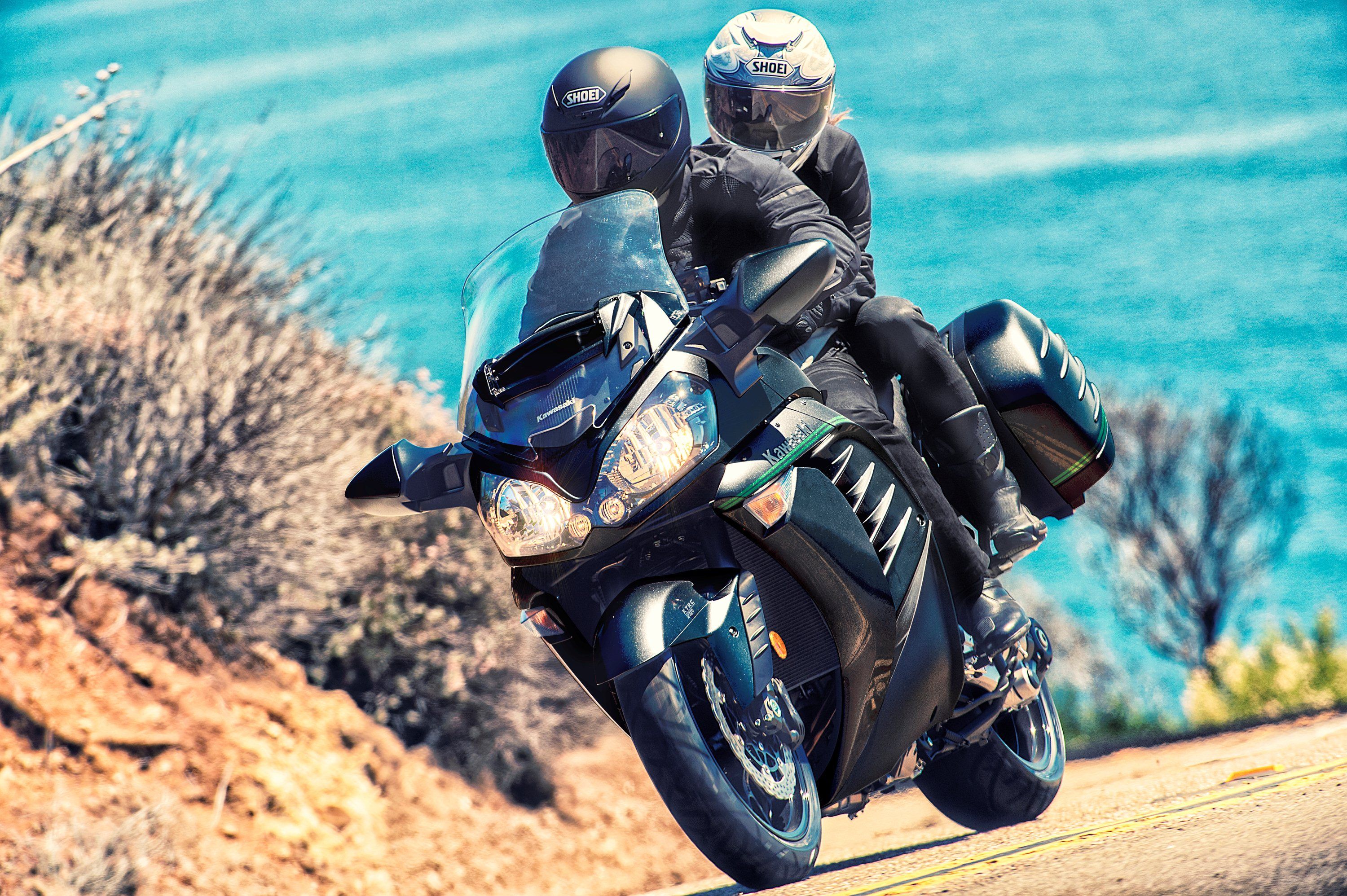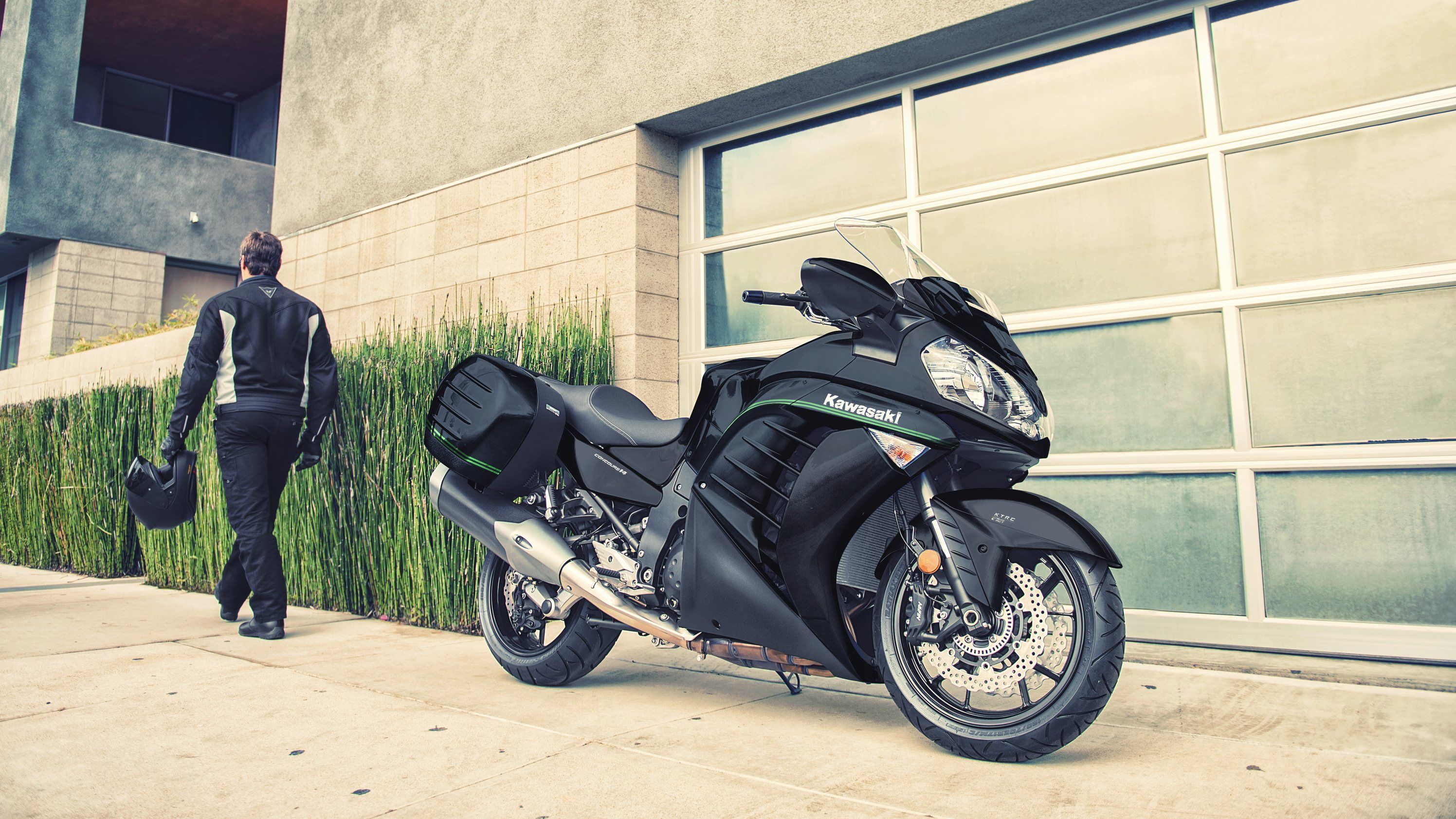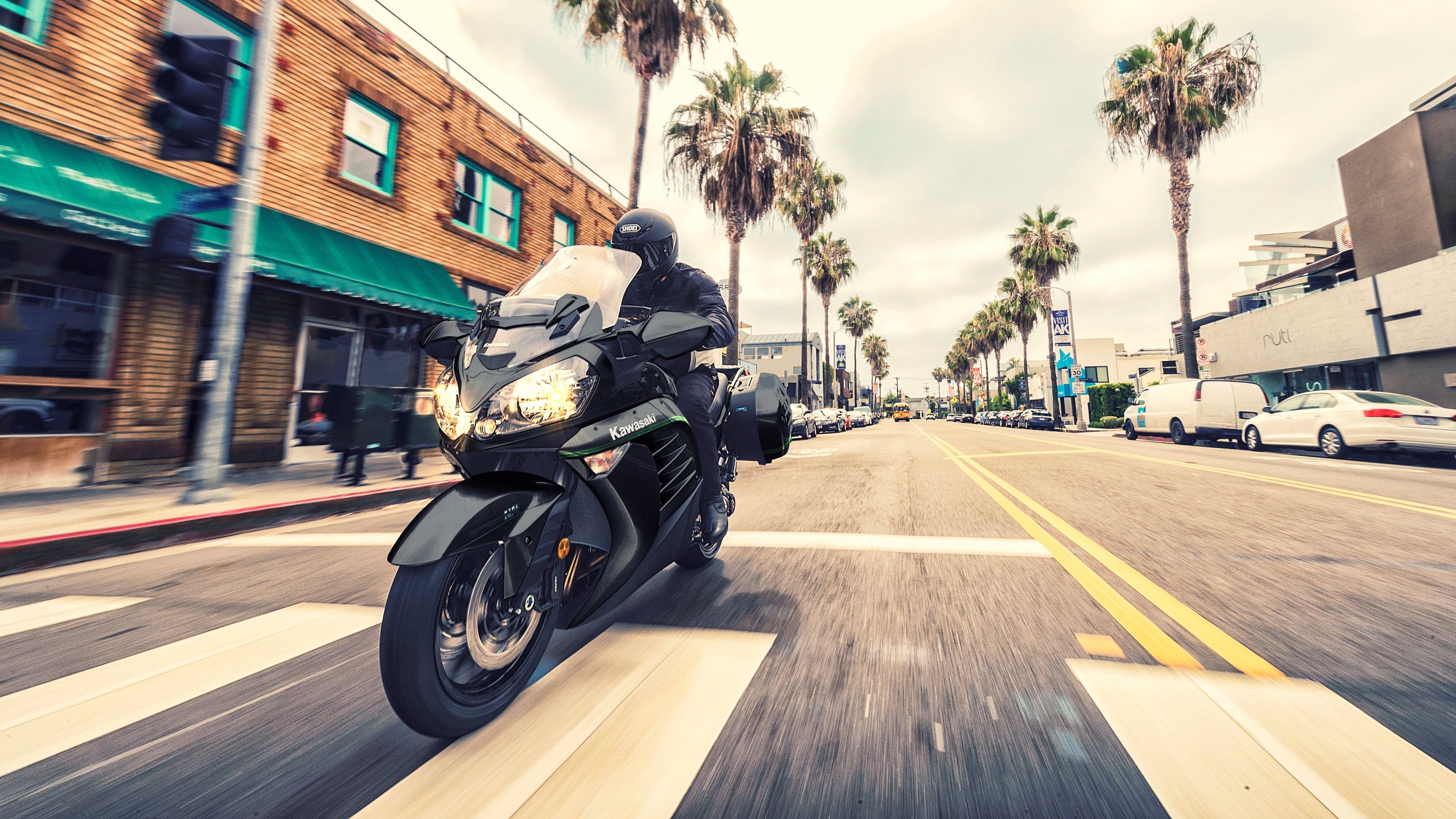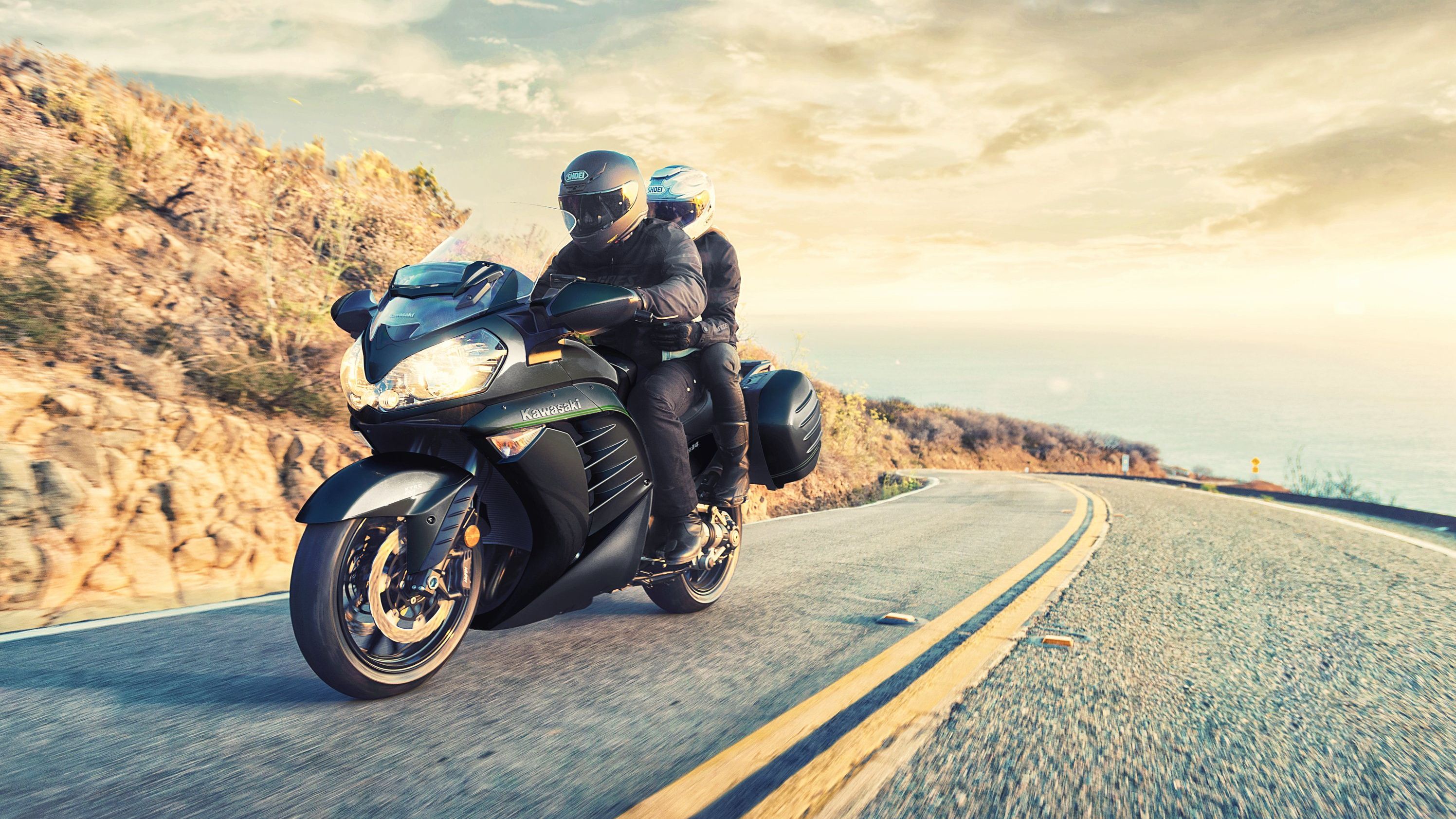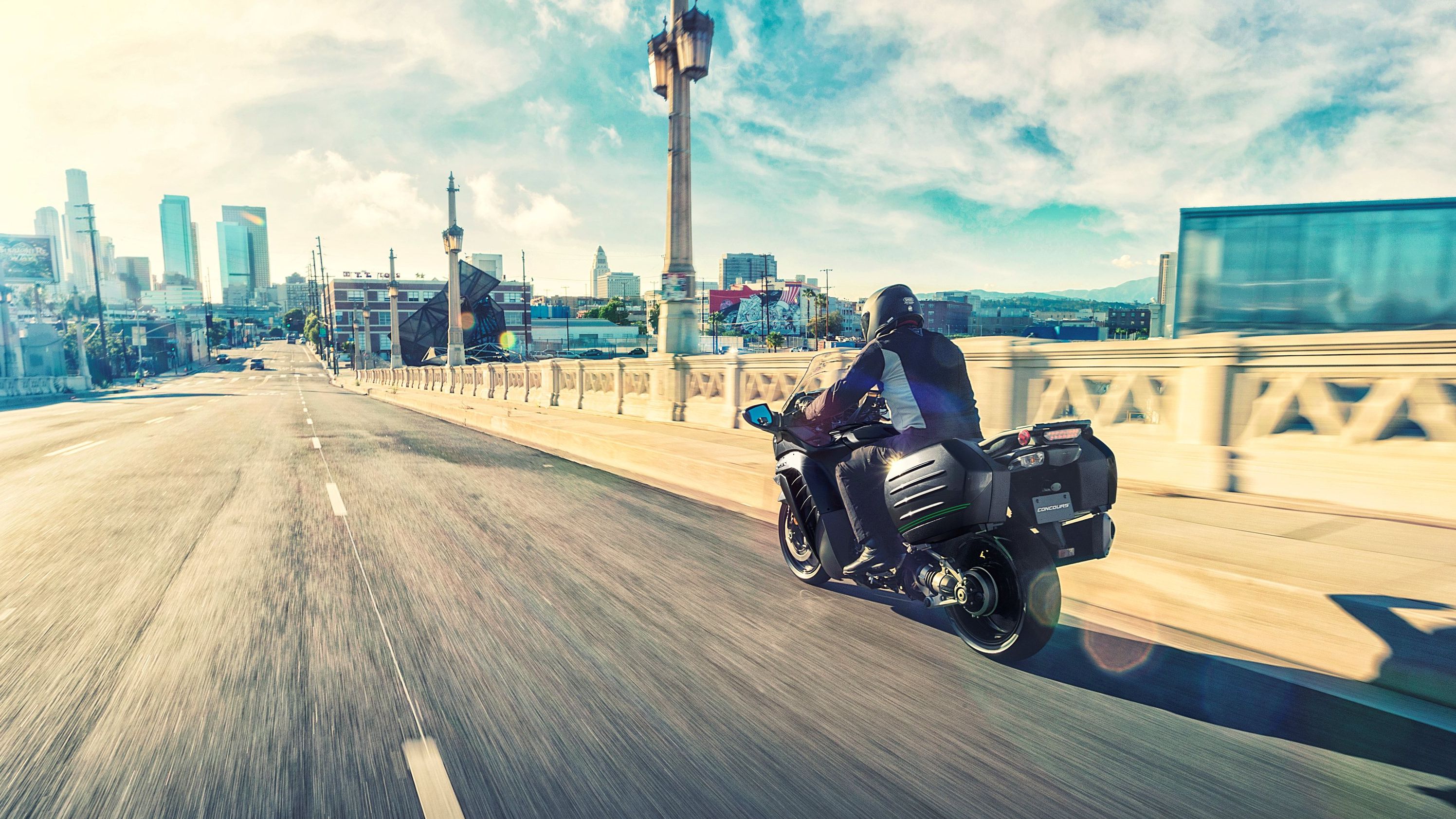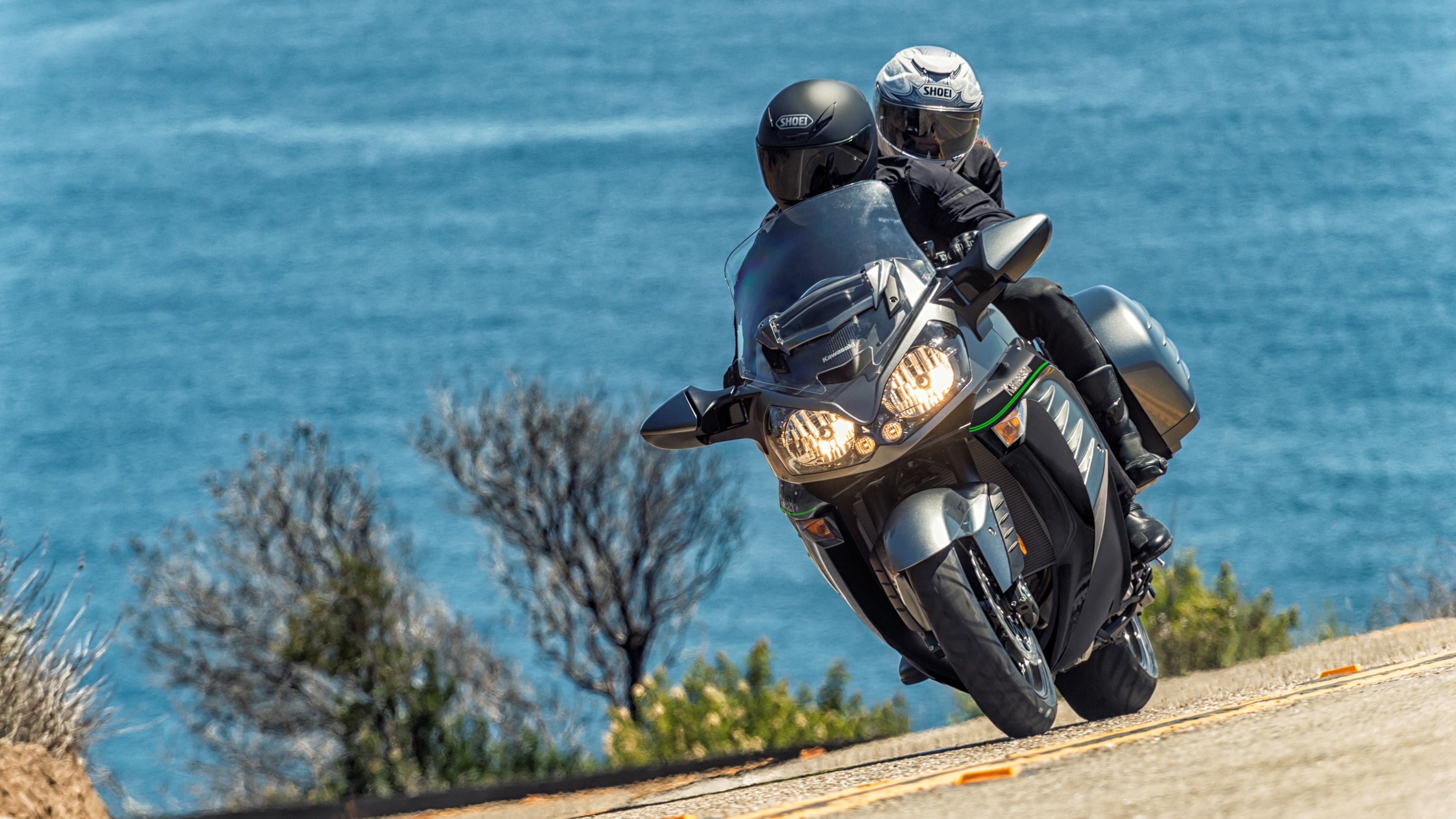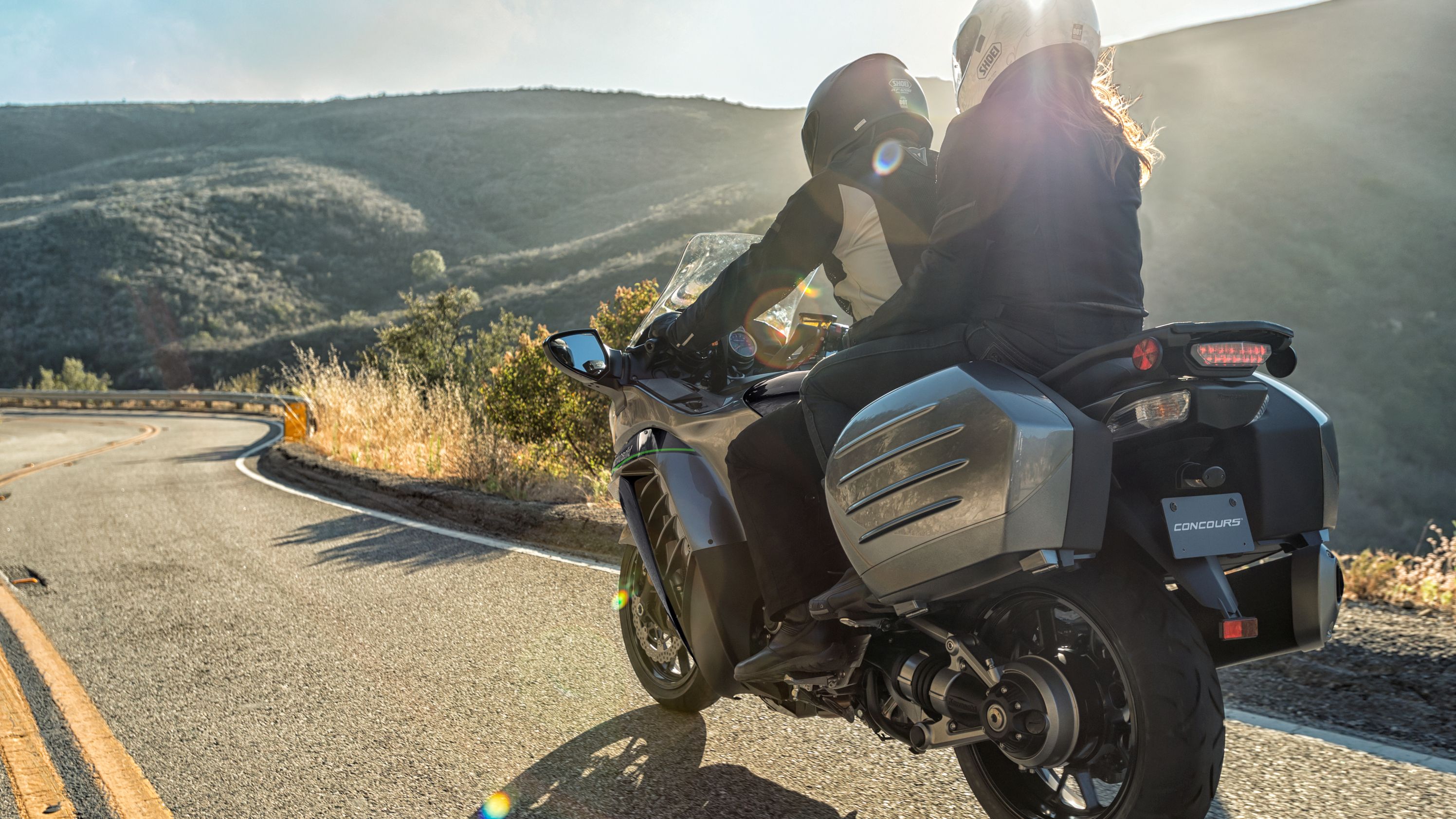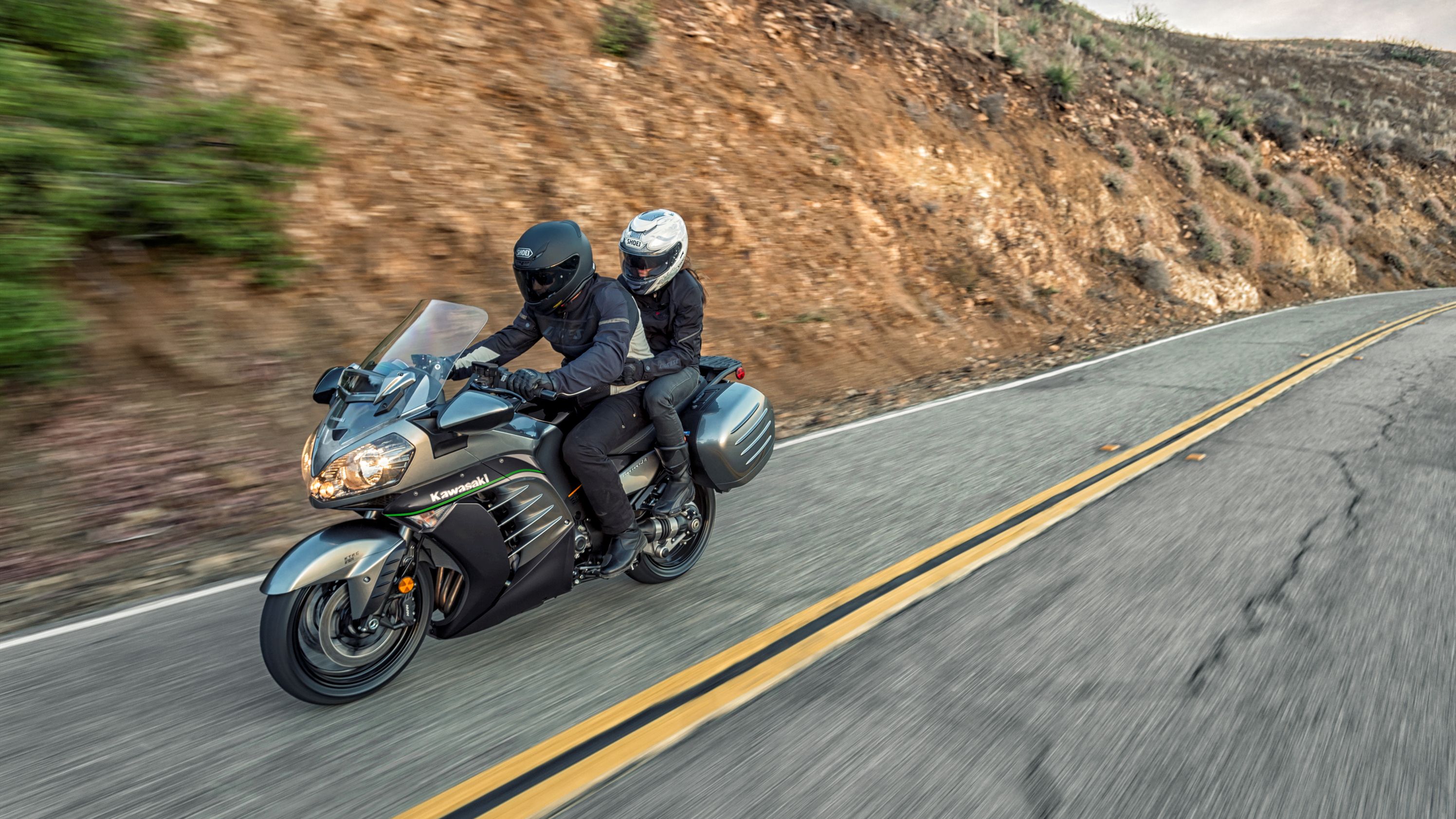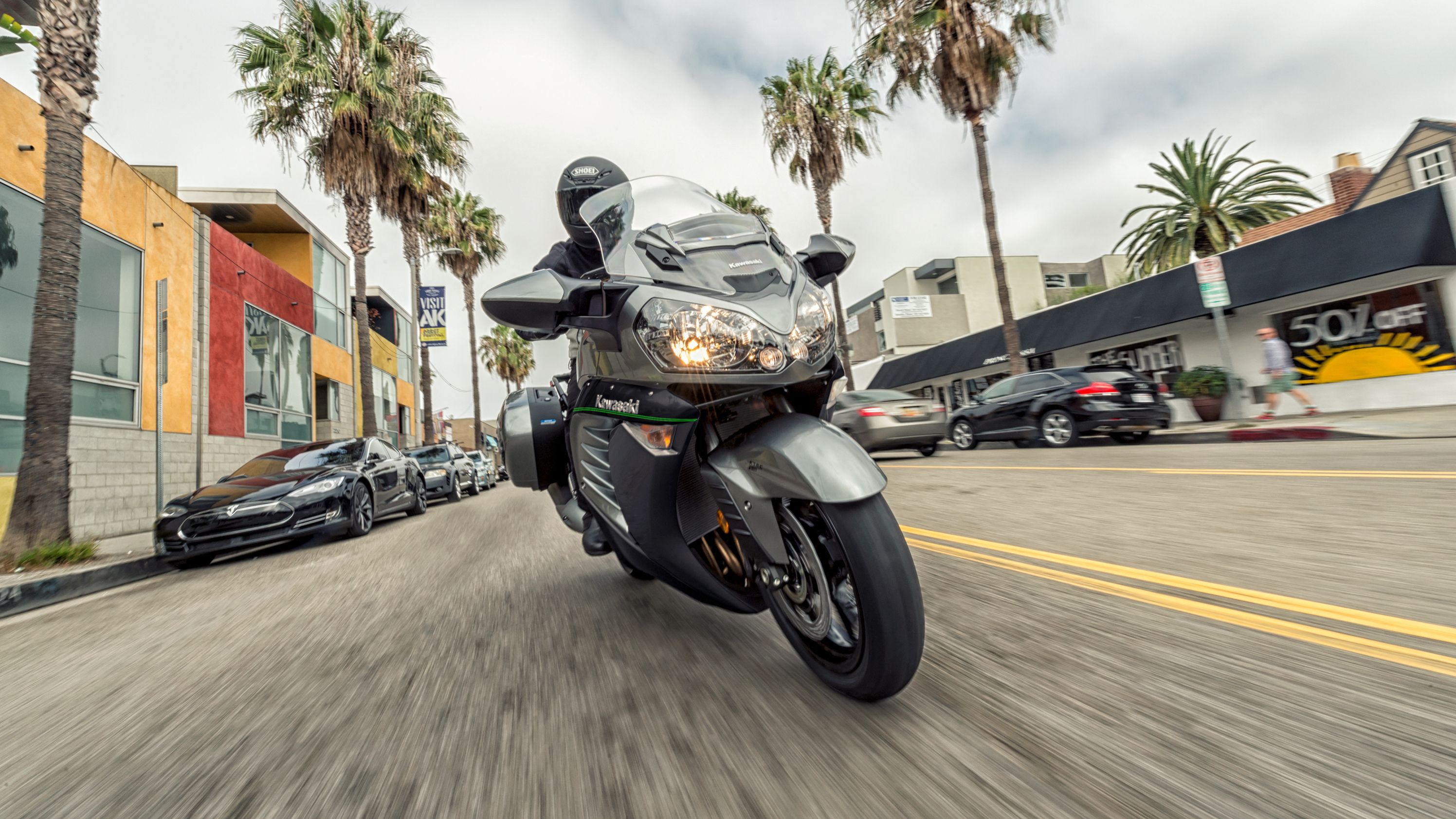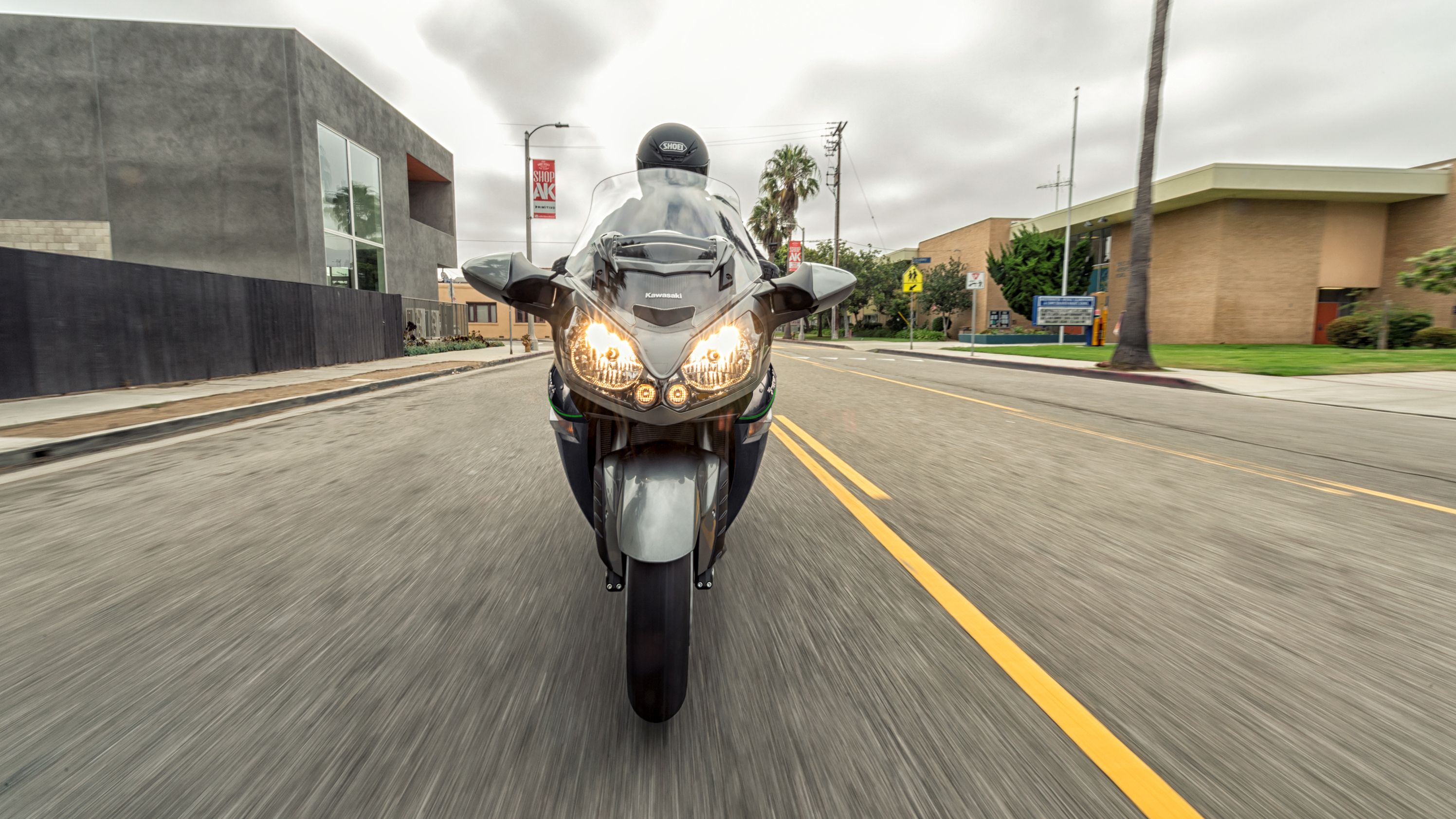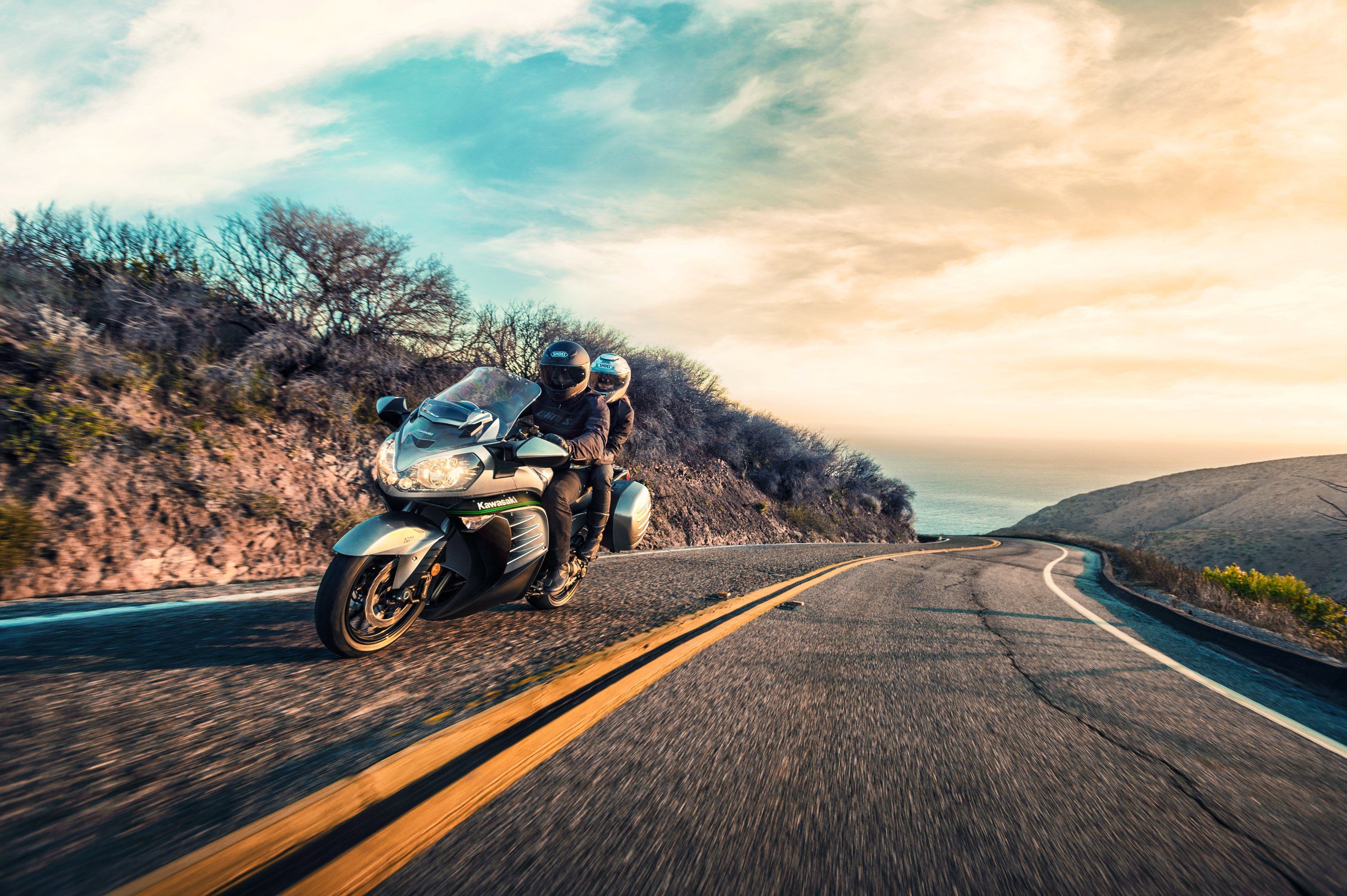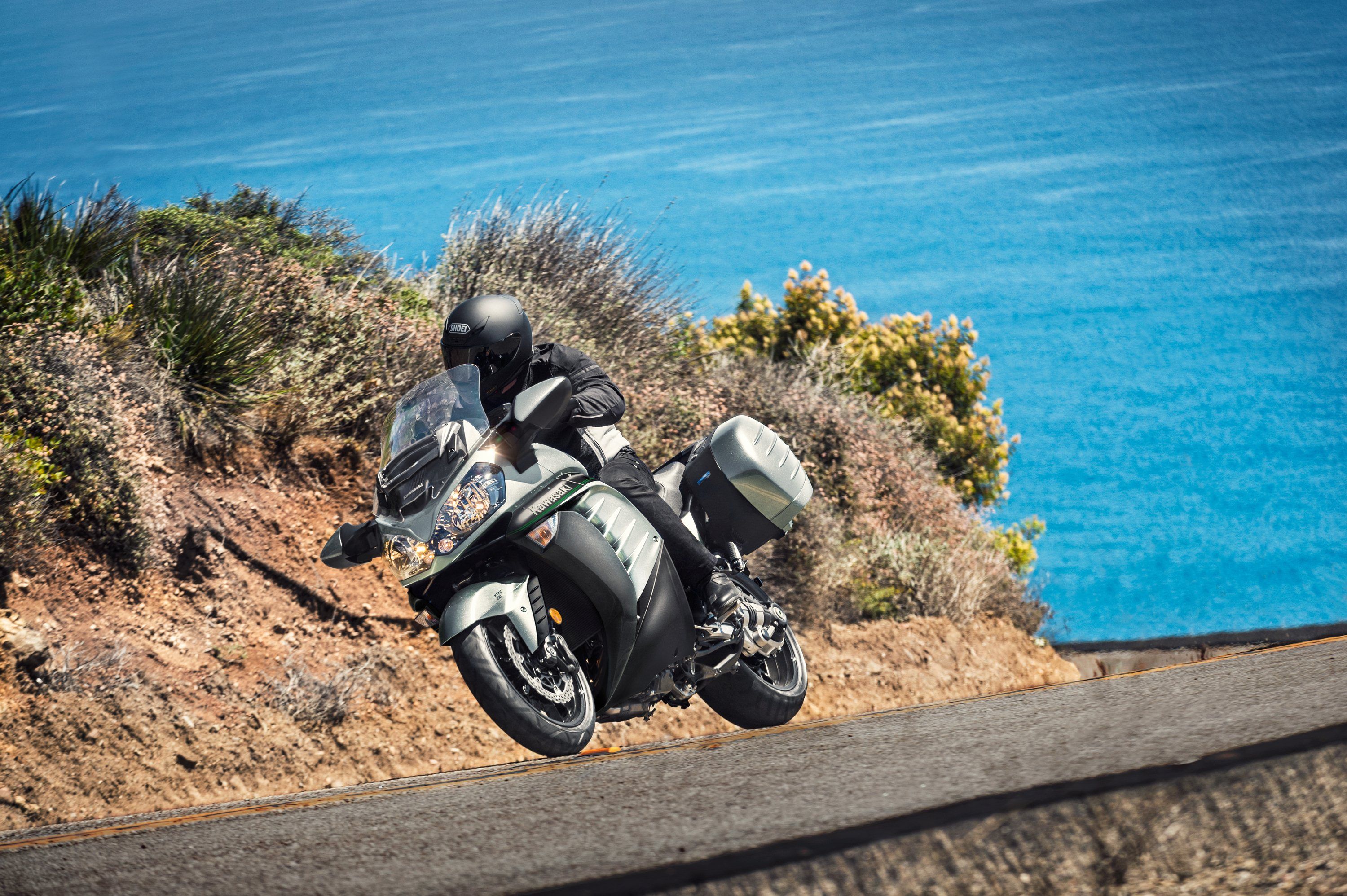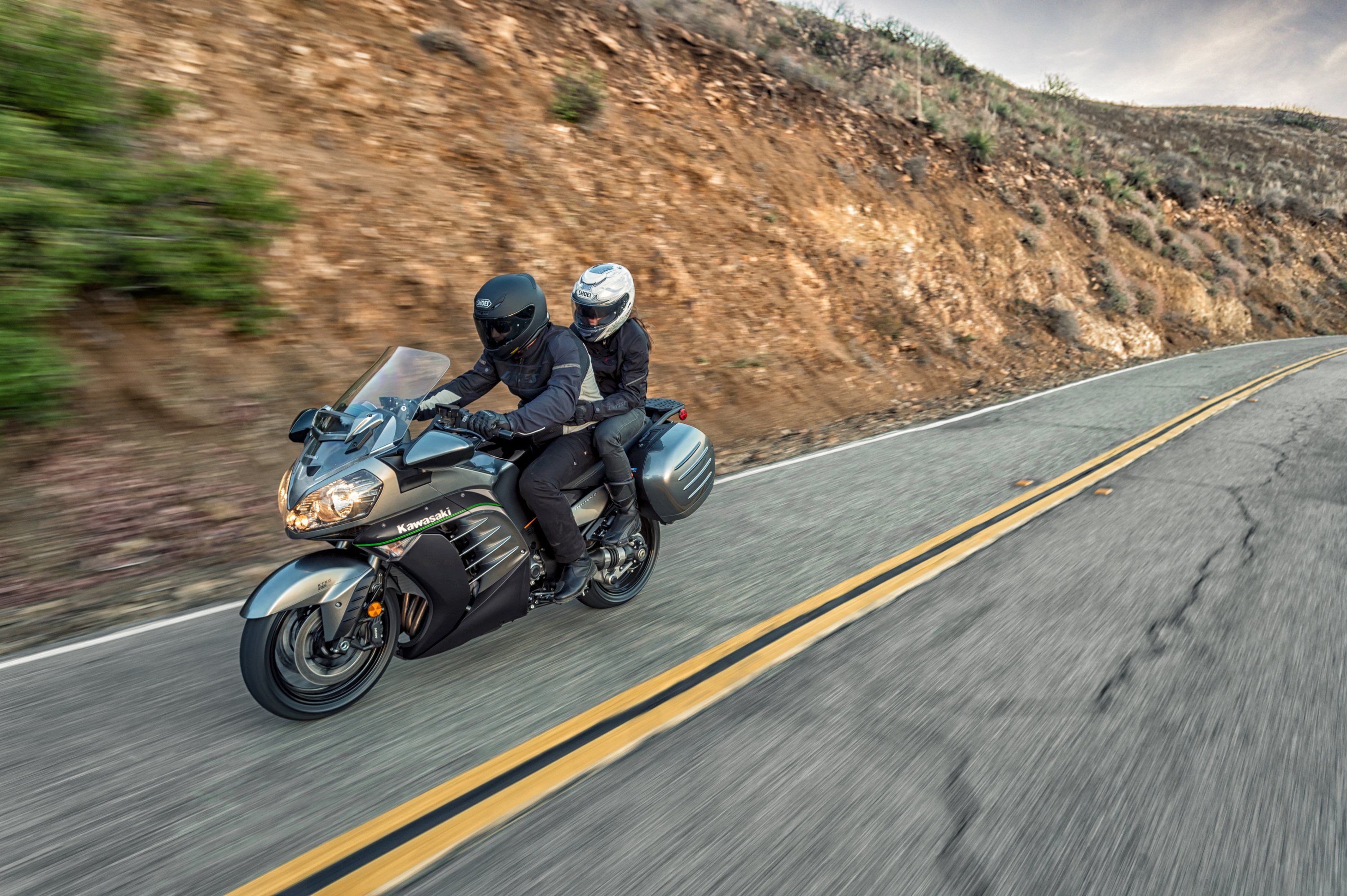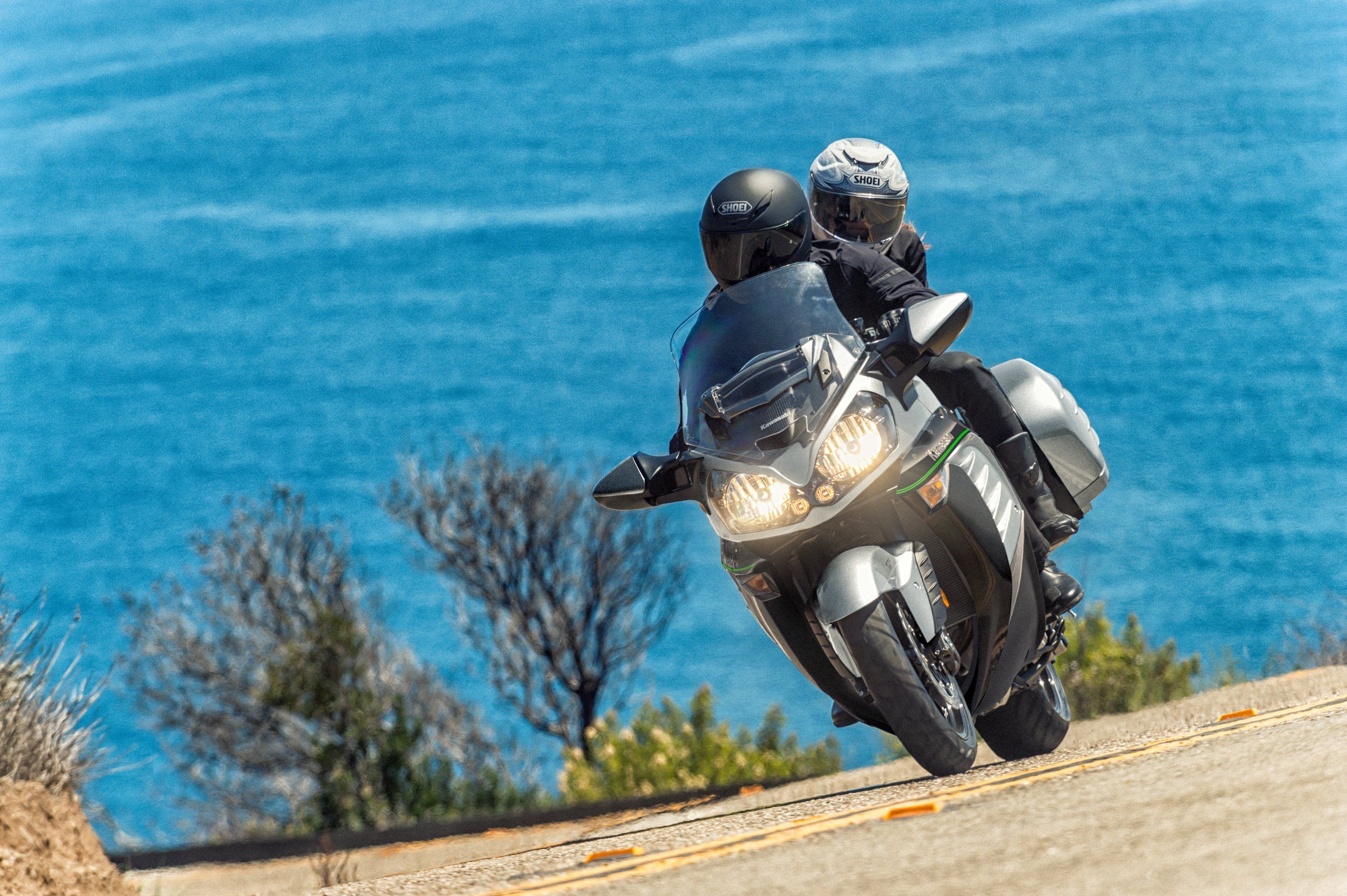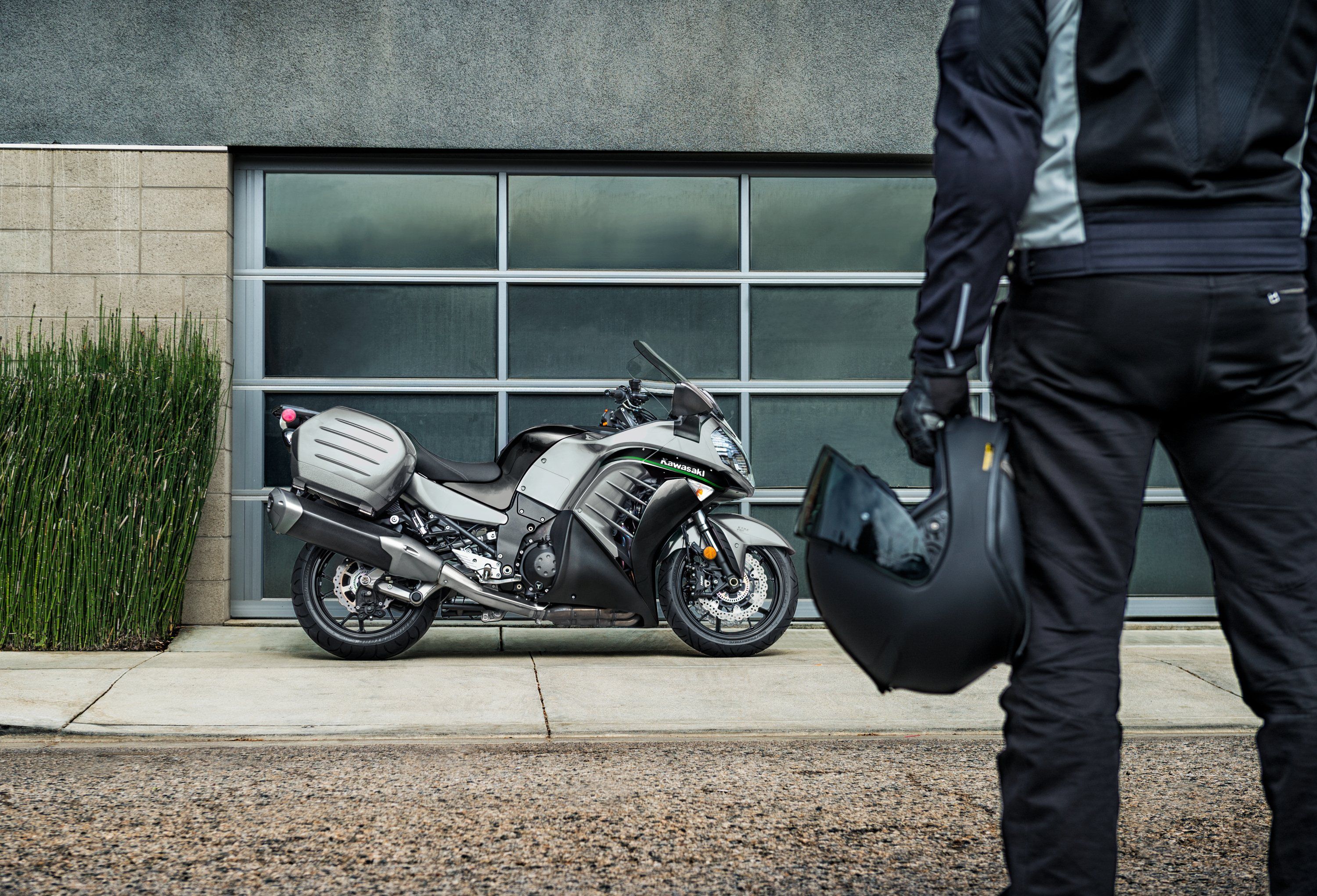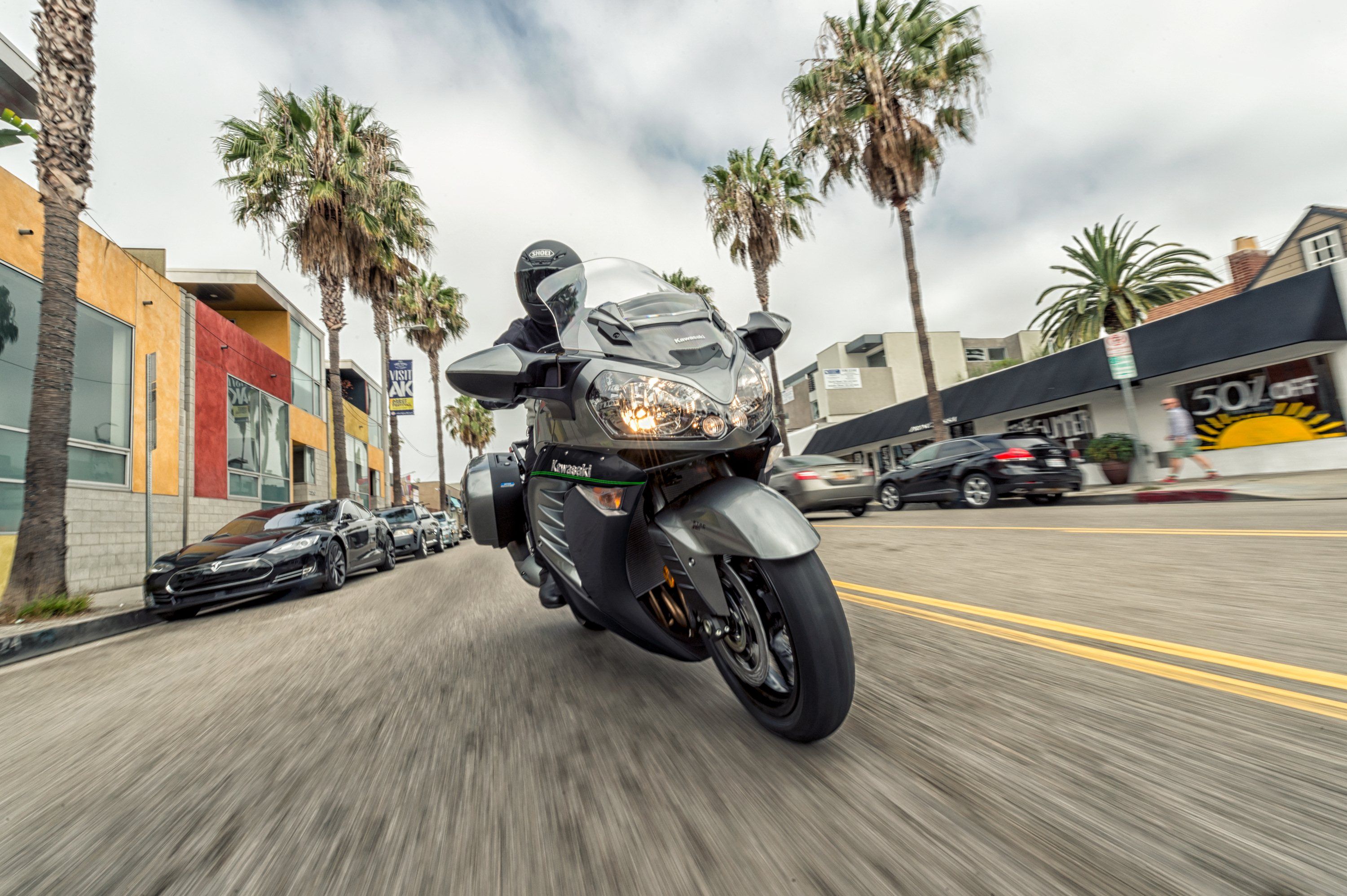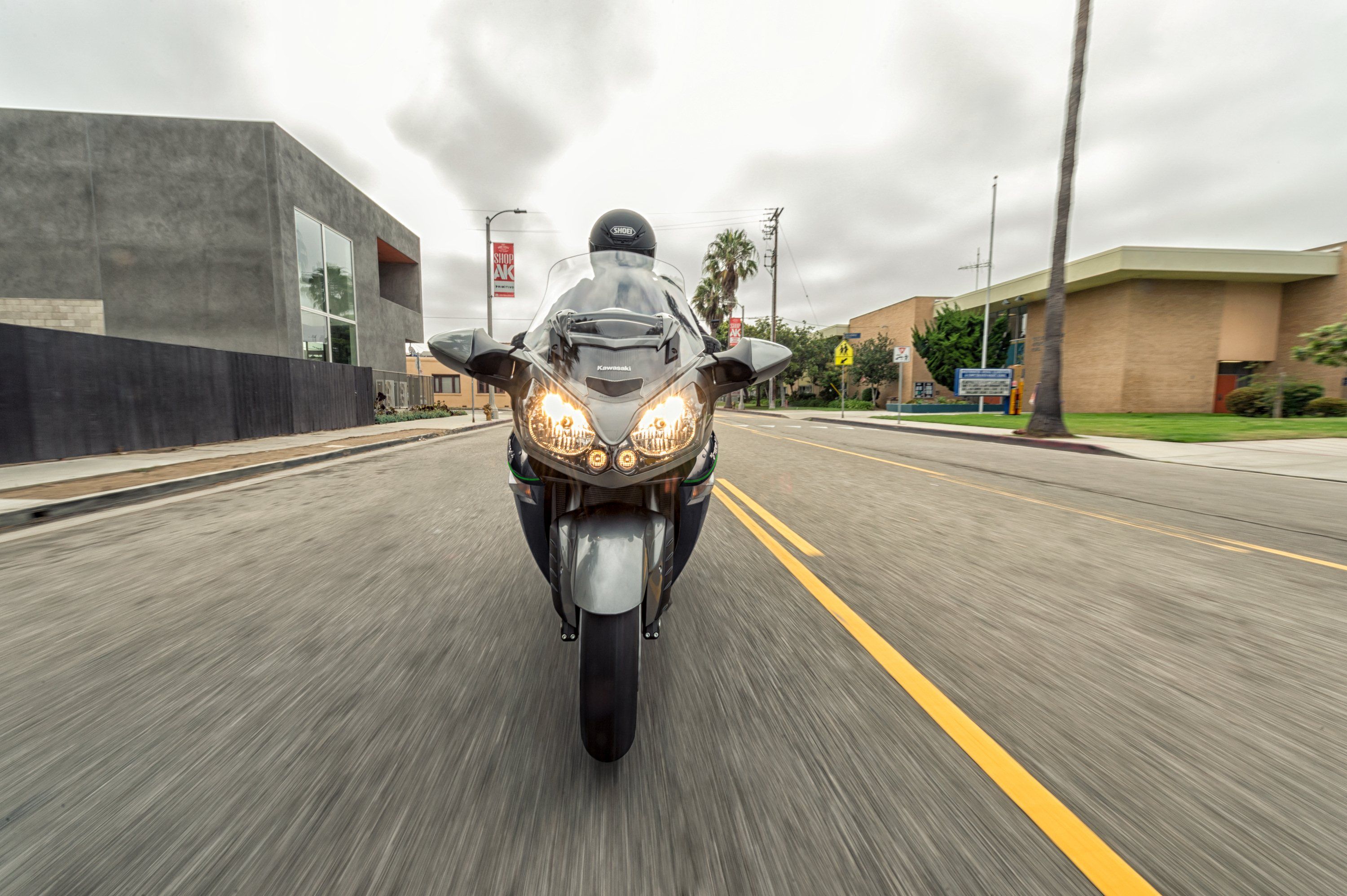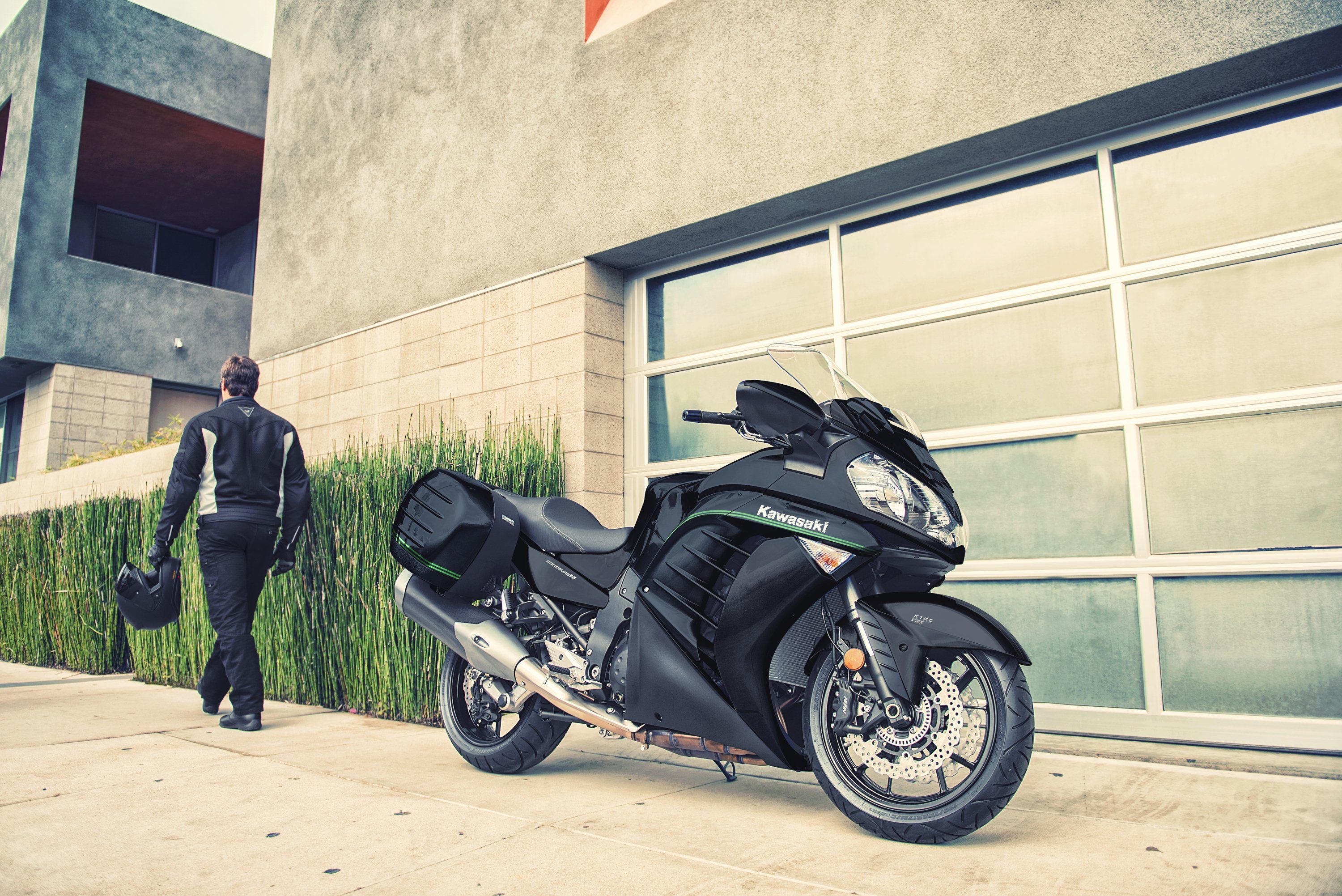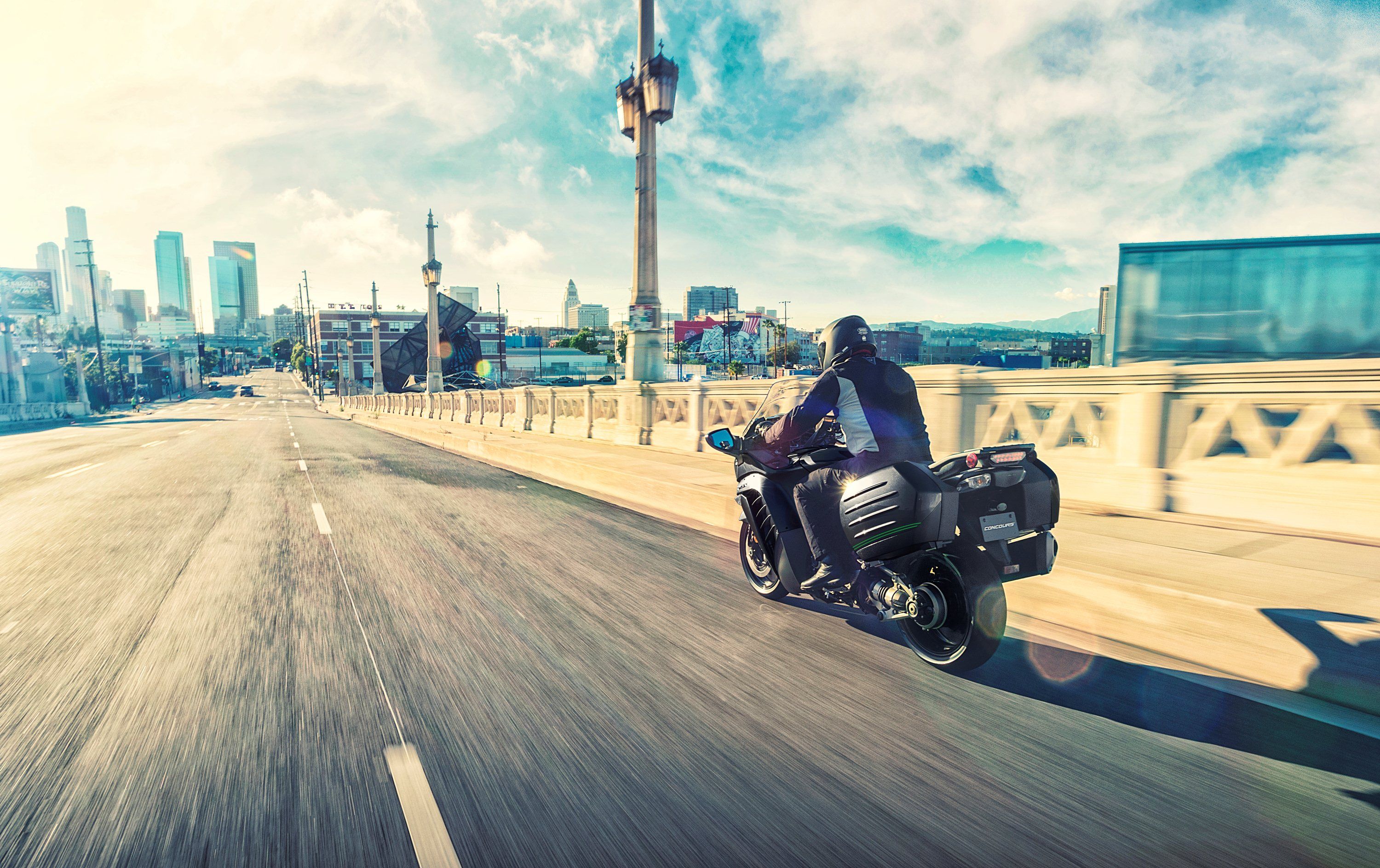Kawasaki delivered the 2015 Concours 14 ABS with a whole slew of improvements over the prior year -- some cosmetic and some for performance -- and carries that over to 2022. At the core, the Kawasaki kept the 1,352 cc engine derived from the Ninja® ZX™-14R in a chassis tuned for touring. The sportbike DNA is quite evident in the overall styling, so whether you love it or hate it, you don't ignore the Concours 14 ABS.
2015 - 2022 Kawasaki Concours 14 ABS
- Make: Array
- Model: 2015 - 2022 Kawasaki Concours 14 ABS
- Engine/Motor: inline-4
- [do not use] Vehicle Model: Array
Kawasaki Concours 14 Design
Take a Ninja® ZX™-14R, tune it for touring and what have you got? If you guessed a Concours 14, you get the prize. Low-speed maneuvering, rider comfort, safety, and handling were all affected by the enhancements. A stainless bezel on the instrumentation gives it just a bit of bling, but revised ABS settings, stiffer rear suspension, reworked first gear ratio, and a heat shield on the exhaust make noticeable improvements to the rider experience.
The "touring" side of this sport-tourer is evident in the rider triangle. By moving the handlebars closer to the rider than they are on the Ninja, you get a more upright and comfortable posture. The 2015 enhancements included a two-up, almost stadium-seating-style rider saddle that is more narrow in the front to make it easier to find the ground, and a flatter pillion to improve passenger comfort. A slip-resistant cover was added to the saddle to keep your butt where you put it, and some fancy double stitching to give it a clean, tailored look.
If the stock seat isn't as tour-rific as you'd like, peruse the accessories catalog for the optional touring seat. Along with a more cushy ride, the seat is made from anti-UV material that keeps the seat from becoming a butt-burner when left sitting in the sunshine. That may not mean as much to you northern folks, but those of us down here in the intense summer sun of the Deep South really appreciate it.
When standing still, a new-from-2015 exhaust shield directs heat away from your legs. In an improvement aimed at wind buffeting when underway, the Concours has an integrated, multi-position vent on the electrically-operated windscreen. The vent directs airflow around you and eliminates that low-pressure pocket behind the fairing.
The Concours 14 comes standard with color-matched quick-release hard saddlebags that lock and unlock with the ignition key as part of Kawasaki's one-key system. To stow your gear and your bits and bobs, there is a glove box in the fairing and each saddlebag holds 22 pounds. For additional storage, hit the accessories catalog for an optional topcase. Then you can have a supersport-touring full dresser.
Kawasaki Concours 14 Chassis
Frequently, big tour bikes run with big, heavy frames to support the engine, copious amounts of body panels and fairings and variable passenger and cargo loads. Even frames made from aluminum stock necessarily add to the weight of the bike, so how do you get around that on the Concours 14?
Kawasaki says the aluminum monocoque body design holds the key. The body panels serve as stressed members, with the engine as the keystone that completes the assembly while bolstering rigidity. This results in a lightweight but strong “frame” with just the right amount of give for comfort. Best of all, this design leaves the bike with a narrow waist, kind of the opposite of riding a barrel, so vertically-challenged riders will have an easier time wrangling the bike than the 32.1-inch seat height might suggest.
The steering head is set for 26 degrees of rake, and a 4.4-inch trail, numbers that ensure nimble handling and quick reversals. New-from-2015, a redesigned steering stem seal allows for easier steering control at low speeds.
Kawasaki's choice of brake systems came off the top shelf. A pair of four-pot calipers bind the dual, 310 mm, wave-cut brake rotors up front, and a single-bore caliper binds the 270 mm rear rotor. The factory used its self-named Advanced Coactive-braking Technology (K-ACT) with ABS to oversee brake operations, and that comes with some interesting features.
Yes, you get the magic that is ABS, but that technology is fairly ubiquitous nowadays and nothing special. What is special is the linked-brake feature that was revised in 2015. The ABS system comes with a "Standard" mode that provides a normal-feeling initial bite, then progressively balances the brakes as pressure is increased. The "High Combined" mode links the brakes at the slightest pressure, and this balanced braking effort is especially good for highway jaunts, with or without the variable of passenger and cargo weight. Not to be outdone, the ABS also comes with two separate rider modes with varying levels of intervention to prevent wheel slip.
A tire-pressure monitoring system (TPMS) keeps an eye on the tire pressure for you, eliminating the need to physically check your air so diligently. Thin-spoked cast rims mount the 17-inch hoops, and the front wheel comes at the end of 43 mm, usd forks with adjustable spring preload and rebound damping features.
The monoshock in back works with the Tetra-Lever linkage on the swingarm to support the rear, and it boasts a remote-mount, spring preload adjuster and stepless rebound damping for easy and precise adjustments. As part of the 2015 improvements, the rear suspension has stiffer settings for better control and carrying capability. With 4.4 inches of wheel travel in front and 5.4 inches in back, plus the adjustable parameters, this suspension proves adequate to the stated job of extended highway travel.
|
Frame: |
Monocoque Aluminum |
|
Suspension, Front: |
43 mm inverted, telescopic fork with adjustable rebound damping and spring preload, 4.4-inch travel |
|
Suspension, Rear: |
Tetra-Lever with stepless rebound damping adjustment and remote spring preload adjuster, 5.4-inch travel |
|
Rake: |
26° |
|
Trail: |
4.4 inches |
|
Brakes, Front: |
Dual floating 310 mm petal-style rotors with four-piston calipers, ABS |
|
Brake, Rear: |
Single 270 mm petal-style rotor, single-piston caliper, ABS |
|
Wheel, Front: |
J17M/C x MT3.50 |
|
Wheel, Rear: |
J17M/C x MT6.00 |
|
Tire, Front: |
120/70 ZR-17 |
|
Tire, Rear: |
190/50 ZR-17 |
Kawasaki Concours 14 Drivetrain
They call the Concours 14 a sport-tourer, and it wasn't hard to figure out where the “sport” part came from. That particular DNA was gifted to this ride from the Ninja ZX-14R, and even though it comes with more of a tour-tastic torque curve and power delivery, the Ninja roots come out in the performance. The 1,352 cc, four-banger mill puts out some decent numbers, especially for a “tour” bike. With 100 pound-feet of torque at 6,200 rpm and 150-plus horsepower at 8,800 rpm, this mill can keep up with nearly anything on the highway under reasonable circumstances.
Kawasaki's Variable Valve Timing (VVT), fuel injection, and ram-air intake tracts contribute to this great power, and a "Fuel Economy Assistance" mode makes the engine sip fuel on long hauls. The KRTC traction control feature rounds out the electronics by intervening to prevent loss of traction due to rear-wheel slippage, a tasty feature for foul-weather riders.
A six-speed transmixxer sends power to the rear wheel down the Tetra-Lever shaft drive with anti-squatting and anti-lifting features, so you don't get that dreaded and dangerous shaft behavior. A new first gear ratio, as part of the 2015 improvements, makes low-speed maneuvering easier and gives you better standing starts.
|
Engine: |
Four-stroke, Four-cylinder, DOHC, Four-valve, liquid-cooled |
|
Displacement: |
1,352 cc |
|
Bore x Stroke: |
84.0 mm x 61.0 mm |
|
Compression Ratio: |
10.7:1 |
|
Maximum Power: |
158 Horsepower at 8,800 rpm |
|
Maximum Torque: |
100 Pound-Feet at 6,200 rpm |
|
Fuel System: |
DFI® with four 40 mm throttle bodies |
|
Ignition: |
TCBI with Digital Advance |
|
Transmission: |
Six-speed |
|
Final Drive: |
Tetra-Lever shaft drive |
Kawasaki Concours 14 Pricing
MSRP on the 2022 Concours 14 ABS is $15,999 and comes in an uninspired Metallic Spark Black. Kawasaki covers your Concours 14 with a 36-month limited warranty with optional Kawasaki Protection Plus™ for 12, 24, or 36 months.
|
Warranty: |
36-Month Limited Warranty with optional Kawasaki Protection Plus™ 12, 24, or 36 months |
|
Colors: |
|
|
└ 2015: |
Candy Lime Green, Metallic Spark Black |
|
└ 2016: |
Metallic Moondust Gray, Metallic Spark Black |
|
└ 2017: |
Candy Imperial Blue |
|
└ 2018: |
Metallic Carbon Gray/Metallic Flat Spark Black |
|
└ 2019, 2020: |
Metallic Matte Fusion Silver/Metallic Spark Black |
|
└ 2021, 2022: |
Metallic Spark Black |
|
Price: |
|
|
└ 2016: |
$15,499 |
|
└ 2017 - 2020: |
$15,599 |
|
└ 2021: |
$15,799 |
|
└ 2022: |
$15,999 |
Kawasaki Concours 14 Competitors
Kawi's Concours 14 is, due to its sporty configuration and engine DNA, arguably just a Ninja with bags. Stock bags are a rare thing on tour bikes from across either pond, but BMW's R 1250 RT is one such sport-tour machine so I'm going to give the Bayerische a crack at it.
BMW R 1250 RT
Beemer's premier sport-tour machine poses a serious threat to the Concours. It has the stock storage, the pushbutton-adjustable windscreen and the windtunnel-tested look that looks fast sitting still. It's hard to beat Beemer for fit-and-finish, and the factory doesn't disappoint as every component looks well thought out and planned. Even the bags go with the rest of the machine, though the ribs in the Kawi's panniers tie front and back together even better than the Beemer. One of the largest differences, however, is both visible and inconspicuous at the same time; Kawi uses a monocoque structure, while Beemer is a bit more old-fashioned with a stressed-engine frame that is completely hidden by the bodywork structure, while Beemer is a bit more old-fashioned with a stressed-engine frame that is completely hidden by the bodywork}}.
Beemer falls behind a skosh in the suspension with non-adjustable front forks that have to face down Kawi's ajustable preload and rebound-damping features. Out back, BMW manages to not lose more ground by offering adjustable preload and rebound damping, not entirely unlike the Concourse. Kawi also gets a leg up in the brakes with its Advanced Coactive-braking feature that electronically distributes brake pressure between front and rear, and that's a stability related feature to which BMW has no answer, even though it does come with Beemer's proprietary anti-locks that can be switched off if you've got the skills for it.
The RT enjoys increased engine output this year with 105 pound-feet of torque against 100.5-pounds o' grunt. That's not nearly enough to justify buying one bike over the other, and both should be considered technological marvels with their variable cam-timing wizardry, but there's no escaping the fact that the Germans put out a better electronics suite here.
Prices are what you'd expect. The hot-shot BMW makes you pay for that tech with a $18,645 sticker that leaves quite a lot of meat on the bone for the $15,999 Kawasaki. That's likely enough to buy the Japanese heavy some business.
Read our full review of the BMW R 1250 RT.
He Said
My husband and fellow writer, TJ Hinton, says, “Definitely a sharp-looking bike, but I question whether engine-tuning and a couple of bags is enough to turn this thoroughbred into a creature docile enough to ever be truly comfortable for the longest hauls. It's a Ninja with bags, though the reworked rider triangle will allow for a relaxed, upright position, a big advantage on the highway over its pure-sport siblings.”
She Said
"Before the revamp in 2015, the proportioning of the linked brakes was a little hinky. When trail-breaking into a corner and giving it a little rear brake, the bike wanted to pitch forward because some of that pressure was proportioned to the front brake -- at least that's how it felt -- and it could be a bit of a surprise if you weren't ready for it. I was glad that part of the revamp involved revising the linked ABS proportioning."
Kawasaki Concours 14 Specifications
|
Engine & Drivetrain: |
|
|
Engine: |
Four-stroke, Four-cylinder, DOHC, Four-valve, liquid-cooled |
|
Displacement: |
1,352 cc |
|
Bore x Stroke : |
84.0 mm x 61.0 mm |
|
Compression Ratio: |
10.7:1 |
|
Maximum Power: |
158 hp @ 8,800 rpm |
|
Maximum Torque: |
100 lb-ft @ 6,200 rpm |
|
Fuel System: |
DFI® with four 40 mm throttle bodies |
|
Ignition: |
TCBI with Digital Advance |
|
Transmission: |
Six-speed |
|
Final Drive: |
Tetra-Lever shaft drive |
|
Chassis: |
|
|
Frame: |
Monocoque Aluminum |
|
Suspension, Front: |
43 mm inverted, telescopic fork with adjustable rebound damping and spring preload, 4.4-inch travel |
|
Suspension, Rear: |
Tetra-Lever with stepless rebound damping adjustment and remote spring preload adjuster, 5.4-inch travel |
|
Rake: |
26° |
|
Trail: |
4.4 inches |
|
Brakes, Front: |
Dual floating 310 mm petal-style rotors with four-piston calipers, ABS |
|
Brake, Rear: |
Single 270 mm petal-style rotor, single-piston caliper, ABS |
|
Wheel, Front: |
J17M/C x MT3.50 |
|
Wheel, Rear: |
J17M/C x MT6.00 |
|
Tire, Front: |
120/70 ZR-17 |
|
Tire, Rear: |
190/50 ZR-17 |
|
Dimensions & Capacities: |
|
|
Length: |
87.8 inches |
|
Width: |
With Saddlebags - 39.4 inches, Without Saddlebags - 31.1 inches |
|
Height: |
windscreen down - 52.9 inches, windscreen up - 57.7 inches |
|
Ground Clearance: |
4.9 inches |
|
Minimum Turning Radius: |
126 inches |
|
Seat Height: |
32.1 inches |
|
Wheelbase: |
59.8 inches |
|
Curb Weight: |
690.2 pounds |
|
Storage Capacity: |
22 pounds per bag |
|
Fuel Capacity: |
5.8 gallons |
|
Details: |
|
|
Warranty: |
36-Month Limited Warranty with optional Kawasaki Protection Plus™ 12, 24, or 36 months |
|
Colors: |
|
|
└ 2015: |
Candy Lime Green, Metallic Spark Black |
|
└ 2016: |
Metallic Moondust Gray, Metallic Spark Black |
|
└ 2017: |
Candy Imperial Blue |
|
└ 2018: |
Metallic Carbon Gray/Metallic Flat Spark Black |
|
└ 2019, 2020: |
Metallic Matte Fusion Silver/Metallic Spark Black |
|
└ 2021, 2022: |
Metallic Spark Black |
|
Price: |
|
|
└ 2016: |
$15,499 |
|
└ 2017 - 2020: |
$15,599 |
|
└ 2021: |
$15,799 |
|
└ 2022: |
$15,999 |
Further Reading
Kawasaki
Read more Kawasaki news.


